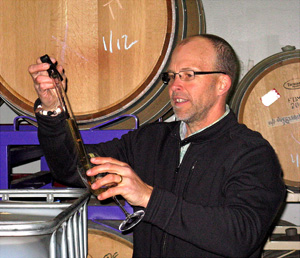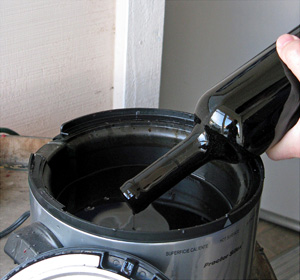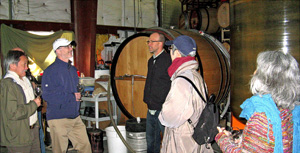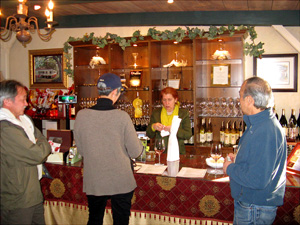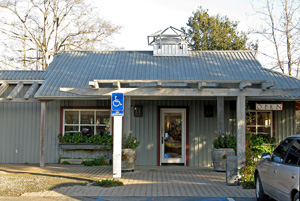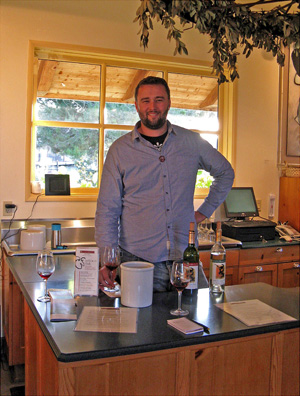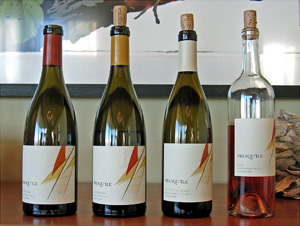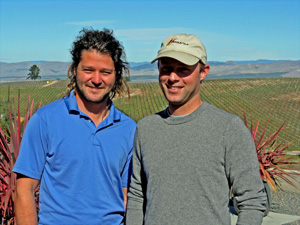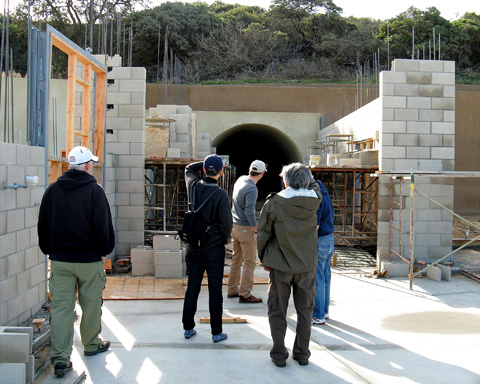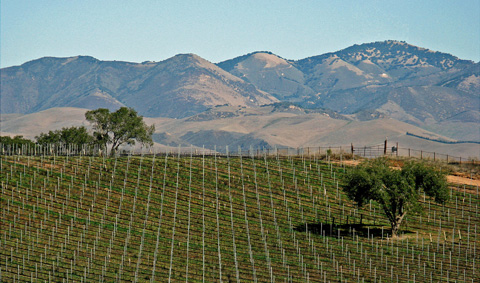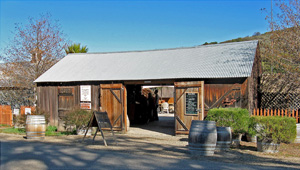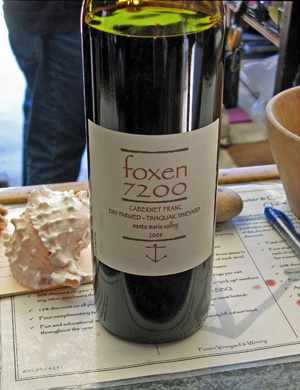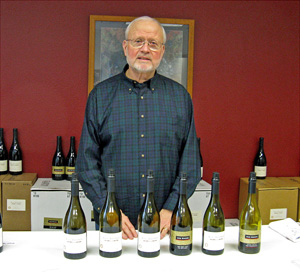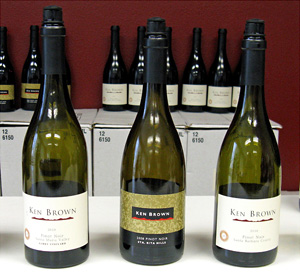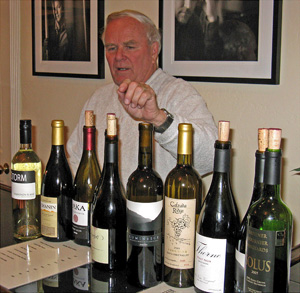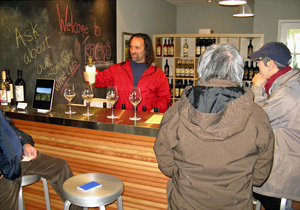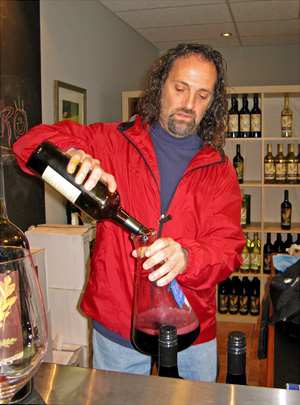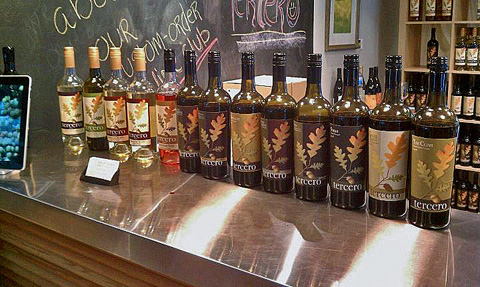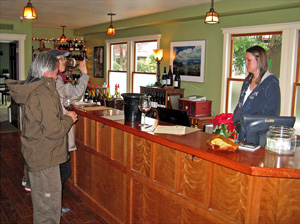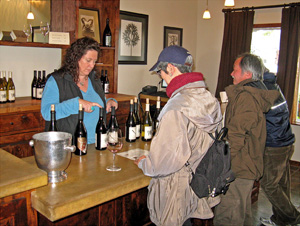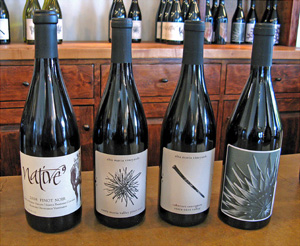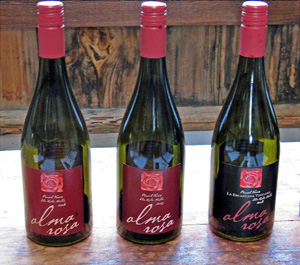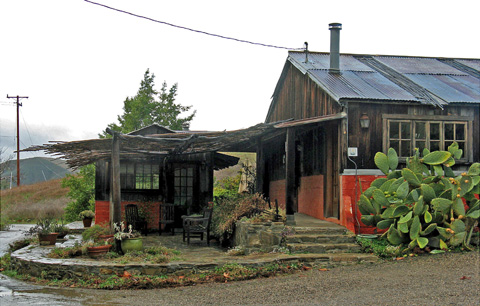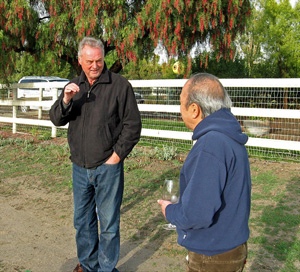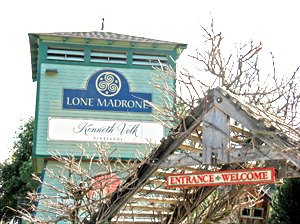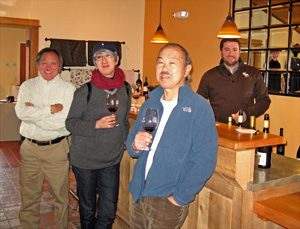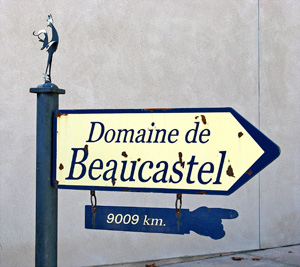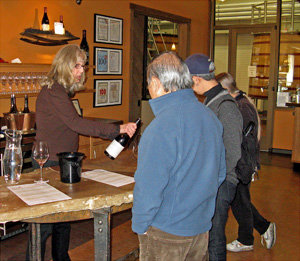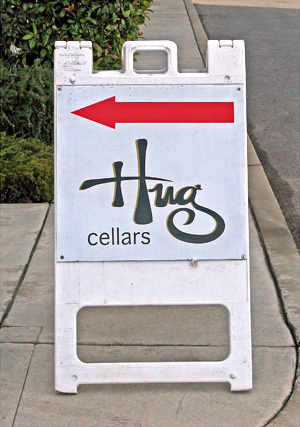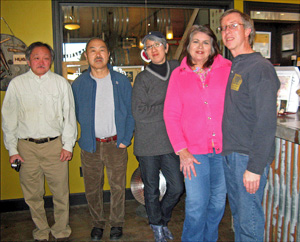Central Coast - January 2012
I traveled with a few friends to the Central Coast in the second half of January. It’s a beautiful place to visit any time of year. The impetus for this trip came from my friend Jane, who had traveled with me and with other friends to the Central Coast wine region many times, but had not been there for the past 4-5 years. Several other friends were able to join us on this short trip – Alan, who’s been to the area many times, and Dean and Ken, who were making their first visit to the region’s wineries.
I worked on our itinerary – with lots of helpful input from Jane – and we came up with a few winery appointments and “must-visit” tasting room stops while allowing time for other visits we could decide upon at the spur of the moment. Since a couple of people in our group had never visited Central Coast wineries before, I didn’t want to get too esoteric in the selection of places to visit. And Jane wanted to revisit some old favorites, a few of which I’d been to in the past couple of years but which are always welcome stops. Add to that a couple of places I hadn’t visited for a few years and some that were first-time visits for me, and it turned out to be a nice mixture of new and familiar wineries over the course of four days of touring.
Because of our various schedules, we were not able to leave the San Francisco area until late Friday afternoon. After dealing with both rush-hour traffic and occasional heavy rain on our drive south, we arrived in Paso Robles around 8pm. We stopped to check in at my usual place to stay in Paso – the old Melody Ranch Motel on Spring Street – before making a short walk across the nearby town square for dinner. We met long-time friend Raquel Hug of Hug Cellars and her nephew Jaime Serna, who is now working full-time at the winery, at Villa Creek Restaurant, one of Paso’s top dining destinations. As usual, our dinner was very good there – I had a delicious pork chop – and of course we opened some tasty wines at the table.
Our first winery appointment on Saturday was not until 11am, about an hour’s drive south in Santa Maria, so we were able to have a leisurely morning. We stopped for a light breakfast at Hush Harbor Bakery in Atascadero before continuing on our way.
| Saturday
- January 21, 2012 |
Core Wine Company / Kuyam / C³ / Turchi
Dave and his wife Becky were already wine industry veterans when they launched the Core label in 2001. They now produce wines under four labels – Core, Kuyam, C³, and Turchi – all involving different family members. Core focuses on Rhône varieties, Kuyam features Bordeaux-style blends, C³ produces Tempranillo-based wines, and Turchi makes mostly value-priced varietal wines. Dave told us that he may spin off the “Hard Core” wine into a separate label in the future. The total production averages around 7-8,000 cases per year. Becky designs the labels in addition to taking care of other parts of the business.
Tasting Notes: Tank & Barrel Samples |
Core 2007 “b.core,” Santa Ynez Valley (from tank). Sourced from Camp 4 Vineyard, 75% Roussanne, 25% Marsanne, 100% malolactic fermentation, about 52 months in barrel. Medium gold color, with nutty stone fruit, melon, and honey aromas. Fairly rich texture, with a slight bite on the finish. Developing a nice olderwhite Rhône character for a wine that is still to be bottled.
Core 2007 “Hard Core,” Santa Barbara County (from tank).37% Mourvèdre, 33% Cabernet Sauvignon, 26% Syrah, 4% Grenache, about 52 months in barrel. Medium-dark purple, showing ripe cassis and plum, plus smoke, earth, herb, and oak notes. Lively on the palate, with a relatively smooth finish and moderate tannins.
Kuyam 2007 “Cuvée Nolan,” Santa Barbara Highlands Vineyard, Santa Barbara County (from tank). 71% Cabernet Sauvignon, 20% Cabernet Franc, 5% Petite Verdot, 4% Merlot, about 52 months in barrel. Medium-dark color, with herbal, smoky plum on the nose, with a touch of stony minerals. Nice structure in the mouth, with a somewhat grippy tannic finish, nice.
Core 2008 “Mister Moreved,” Alta Mesa Vineyard, Santa Barbara County (from 600-gallon oak cask).Sample tasted was 100% Mourvèdre, final blend will probably have a little Grenache blended in. Dark color, less fruit-forward than previous two wines, with earth, rare meat, and a chalky, minerally character along with plum and darker berry fruit and a touch of sweet oak. Still showing quite young, with a firm texture and big chewy tannins, this should develop very nicely with more time.
Core 2008 “Elevation Sensation,” Alta Mesa Vineyard, Santa Barbara County (from wood tank).Sample tasted was90% Grenache, 10% Mourvèdre, not yet final blend. Medium purple color, with brighter aromatics, showing strawberry and other red fruits, earth, and herbs. In the mouth, more of the signature Alta Mesa chalky character came out, along with some oak undertones. Medium-bodied with a lingering finish.
Core 2008 “Hard Core,” Santa Barbara County (from wood tank).Mostly co-fermented Cabernet Sauvignon and Syrah, plus Mourvèdre and a little Grenache. Medium-dark color, aromas of ripe plum, spice, and vanilla/oak. Big and rich on the palate but with a juicy character as well, and a very grippy tannic finish.
C³ 2008 Reserve Tempranillo, Santa Barbara Highlands Vineyard, Santa Barbara County (from 270-gallon barrel).The reserve Tempranillo is a barrel selection. This had medium-dark color, showing earthy, minerally plum fruit along with earth and dried herb notes and a touch of vanilla/oak. Lively and structured in the mouth, with big, chewy tannins.
Kuyam 2009 Cabernet Franc / Cabernet Sauvignon,Santa Barbara Highlands Vineyard, Santa Barbara County (from new American oak barrel). 80% Cabernet Franc, 20% Cabernet Sauvignon, co-fermented. Dave is not sure yet what blend this will go into – might be “Cuvée Nolan.” Dark color, with ripe black cherry and plum fruit, vanilla, spice, and green, herbal notes. Another big and structured wine, with firm, youthful tannins. I got the sense that this is still all coming together, with the distinctive green Cab Franc character needing time to meld with the wine’s other components.
Current and Upcoming Releases:
Core 2007 “Core White,” Santa Barbara County. 70% Grenache Blanc, 29% Roussanne, 1% Marsanne, sourced from Santa Barbara Highlands and Camp 4 vineyards, left on skins for 24 hours, aged 18 months in barrel. This had medium-light yellow color, and featured stone fruit, citrus, and petrol aromas. With a fairly viscous texture on the palate and a smooth finish, this is developing some nice bottle-aged character.
Core 2006 “b.core,” Santa Ynez Valley. 73% Roussanne, 27% Marsanne, sourced from Camp 4 and Rodney’s vineyards, aged two years in barrel. Medium-deep gold color, with pear, ripe apple, honey, and almond on the nose. Rich and smooth, this should continue to age well for at least a few more years.
Core 2008 Grenache, Santa Barbara County. 85% Grenache, 15% Syrah. Medium-light ruby color, displaying ripe strawberry and black cherry, lots of spice, and a touch of oak. Lively and medium-light bodied, with mild tannins.
Core 2008 Grenache, Santa Barbara Highlands Vineyard, Santa Barbara County. 100% Grenache, a barrel selection. Medium-light color, this had brighter fresh strawberry aromas along with minerals, spice, earth, and herbs. Juicy acidity on the palate with a tangy finish and moderate tannins, nice.
Core 2007 “Hard Core,” Santa Barbara County.37% Mourvèdre, 33% Cabernet Sauvignon, 26% Syrah, 4% Grenache, aged 42 months in barrel. The Mourvèdre and Grenache were sourced from Alta Mesa Vineyard. Medium-dark color, featuring lots of spice, ripe plums, a savory component, and a touch of minerals. Medium-bodied and structured mouthfeel with a lively finish.
Turchi 2008 Merlot, Santa Barbara Highlands Vineyard, Santa Barbara County. 100% Clone 3 Merlot. Medium-dark color, with plum, black cherry, and herb aromas with a touch of sweet oak. Mouth-coating texture with moderate tannins.
Kuyam 2007 “Cuvée Nolan,” Santa Barbara Highlands Vineyard, Santa Barbara County. 71% Cabernet Sauvignon, 20% Cabernet Franc, 5% Petite Verdot, 4% Merlot, aged 37 months in barrel. Dark color, with upfront earth and spice notes along with blueberry, plum, and herb. Richer mouthfeel than the tank sample, with more weight on the grippy tannic finish.
Kuyam 2007 Grenache / Cabernet Franc / Malbec, Santa Barbara Highlands Vineyard, Santa Barbara County. Blend of equal parts of each variety, aged 50 months in barrel and recently-bottled. This is still without a label, and Dave is not sure yet what it will be – likely a Kuyam blend though it could go under the “Hard Core” label. Medium-dark color, with black cherry, plum, and tobacco/herb aromas along with mineral and spice undertones. Fairly big and structured, with a chewy finish.
|
|
Vineyard sources include Alta Mesa and Santa Barbara Highlands in the far eastern reaches of Santa Barbara County, Fess Parker’s Camp 4 and Rodney’s vineyards in the heart of Santa Barbara wine country, Laetitia farther north in Arroyo Grande, and French Camp in the Paso Robles area. Laetitia owns the Santa Barbara Highlands and Alta Mesa vineyards – Dave farmed Alta Mesa Vineyard himself through the 2008 vintage. On the winemaking side of things, he preferslong, slow fermentations at lower temperatures, and he does notinoculate for malolactic fermentation. He also prefers to add smaller doses of SO2 to his wines in barrel than many other winemakers do. Most cooperage is French and Hungarian oak, though Dave uses some American oak on his Tempranillo, Cabernet, and Syrah. He likes AP John barrels for these, as he feels the oak character from this cooper is not as aggressive as in most American oak barrels.
Dave began by offering us samples of his wines pulled from an arrayof various-sized tanks and barrels – he uses more different shapes and sizes of cooperage than I’ve seen anywhere else. He has been barrel-aging his wines for a longer time in recent years, after finding that they needed more time to develop – he feels the longer barrel-aging will allow the wines to show better and be more drinkable sooner after bottling. Dave told us that most wines are in barrel about two years before blending, then move from smaller to larger cooperage. He’s been experimenting with releasing the same wines with increasing amounts of barrel age – he’s released 30-, 37-, and 42-month barrel-aged bottlings before, will bottle some of the same wines this year after even more time in barrel.
As we finished tasting the last of the tank and barrel samples at the winery, Dave asked whether we had time to taste some bottled wines too. Since we had a pretty flexible schedule for the day, we didn’t hesitate to take him up on his offer. Dave was running the Core tasting room in Orcutt that day (and was already running late), so we followed him there from the winery. I’d been to the tasting room before, and it’s a small but comfortable space located in “Old Town” Orcutt, just south of Santa Maria. There’s a nice display on one of the tasting room walls showing the Corey family history – his family settled in the area in the early 1870s.
We were all getting hungry by this time, so Dave suggested grabbing something to go from one of the nearby cafés, and eating at the tasting room. We settled on burgers, falafels, and fries from Charlie’s King Falafel, right around the corner. We sat around a long, tall wood table that doubles as a second tasting bar when things get busy, and enjoyed our lunches – though in retrospect, my spicy falafel may not have been the best choice for pairing with the wines!
Dave kept bringing out lots of bottles to the table – I tried two whites and six reds, and I probably missed one or two others. Some of the wines in bottle were essentially the same wines we’d tasted from tank at the winery, just with less barrel age prior to bottling. This made for some interesting comparisons, and overall, I liked what the extended barrel age does for these wines. Fortunately for our group, we were able to spend a good deal of time with Dave, as it was a fairly quiet early afternoon at the tasting room. After we’d finished with lunch and tasting, he invited us to help with waxing some Turchi Merlot bottles. I’ve waxed wine bottles before – not my favorite thing to do – so I was happy to let the others give it a try.
Many of the wines from Core and related labels combine ripe fruit with a minerally character, often a tough task to pull off. My favorites of the tasting included the 2007 Kuyam “Cuvée Nolan” and 2008 Core “Mister Moreved” from tank and the 2007 “Core White” and 2007 “Hard Core” from bottle. I feel that Dave Corey’s wines have changed somewhat over the years. The early wines seemed more suitable for earlier drinking, but as Dave’s winemaking has evolved, the more recent releases really need time in the cellar to mellow their grippy tannins and show their best. With their extended barrel aging, I think the latest bottlings point toward a promising direction for these wines.
Rideau Vineyard
We didn’t leave Orcutt until mid-afternoon, so we didn’t have too much time for more winery visits that day, but thought we might be able to squeeze in a couple of them. We drove south on Highway 101, then turned off to Los Olivos, passed through the small town, and continued for a few miles until we came to Rideau Vineyards. A friend of Jane’s had told her that she knows the owner of the winery, so we made sure to make a stop there. Rideau Vineyards is right along Alamo Pintado Road, the main road from Los Olivos to Solvang, but I had never stopped in there before. It’s located right across the road from one of several miniature horse farms in the area – some of the horses are no larger than a big dog!
Tasting Notes: Current Releases |
Rideau 2010 “Iris” Viognier, “Stainless Steel,” Estate, Santa Ynez Valley. Made entirely in stainless steel. Light color, showing ripe tropical fruit with floral and leesy notes. Medium-bodied and smooth, with a slightly sweet finish – I’d guess that this has some residual sugar in it.
Rideau 2009 Grenache Blanc, Camp 4 Vineyard, Santa Ynez Valley. Made entirely in stainless steel. Very light straw color, with ripe apple and white peach aromas along with touches of spice and petrol – an aromatic component I’ve noticed in more and more Grenache Blanc with at least a year or two of bottle age. Medium-light bodied with a smooth finish.
Rideau 2010 “Siempre” Albariño, Santa Ynez Valley. Made in 75% stainless steel and 25% neutral oak. Very light straw color, with melon and pear on the nose along with a slight herb note. Light-medium bodied with a livelier texture than the first two white wines, and a crisp, refreshing finish, nice.
Rideau 2009 Sangiovese, Camp 4 Vineyard, Santa Ynez Valley. 100% Sangiovese, aged 18 months in 30% new oak. Medium-light ruby color, showing cherry, herbs, earth, and a touch of sweet oak. Juicy mouthfeel with a lively and slightly tangy finish.
Rideau 2007 “Iris – Château Duplantier Cuvée,” Estate, Santa Ynez Valley. 60% Syrah, 20% Grenache, 20% Mourvèdre. Aged in 30% new oak. Medium-dark color, with slightly floral ripe dark fruits with earth and white pepper notes. Good structure and moderate tannins.
Rideau 2007 Petite Sirah, Central Coast. Dark color, with ripe dark berry fruit, black pepper, and dark chocolate aromas. Deep and dense in the mouth, with grippy tannins on the finish.
|
|
Winery owner Iris Rideau is originally from New Orleans, where her mother and uncles ran the Creole Bar and Grille in the city’s Creole neighborhood of the Seventh Ward. Moving to Los Angeles when she was ten years old, she eventually started Rideau Insurance Agency in the 1960s, and it’s still a successful business to this day. With her New Orleans Creole heritage and family’s restaurant background, it was natural that she would look to expand upon her love for food and wine, and in 1997, Iris established Rideau Vineyards. She had purchased a 25-acre property in the heart of Santa Ynez Valley in 1995, with the centerpiece being the 19th-century El Alamo Pintado Adobe, now beautifully restored.
The 14-acre Rideau estate vineyard is planted entirely to Rhône grape varieties – mostly Syrah and Viognier, plus some Roussanne, Grenache, and Mourvèdre. Iris felt that these varieties went well with the Creole cuisine that she loved, and the location was well-suited to growing them as well. The winery hosts events featuring food inspired by Iris’ Creole heritage, and paired with her Rideau wines. The winery supplements fruit from its estate vineyard with purchased fruit for many of the wines.
Over the years, the historic adobe on the property has served many functions – stagecoach stop, inn, guest ranch, working ranch – and now part of it serves as Rideau Vineyards’ tasting room. When we were there, I spotted a section of a wall opening that is exposed (though protected by plexiglass) to show the original nineteenth-century adobe construction. The tasting room and surrounding grounds were surprisingly crowded with visitors for a late afternoon in January. We were greeted by Cate Allen in the tasting room, and asked her whether Iris Rideau was around that day, but unfortunately for us she wasn’t.
We settled in at the tasting bar and tried six wines, a couple of them entirely from estate-grown fruit. In addition to the wines we tasted, Rideau produces Chardonnay, Roussanne, Riesling, Rosé, Pinot Noir, Grenache, Mourvèdre, Syrah, and Tempranillo. There are also some blends – “Caren’s Cuvée” (a Malbec/Petit Sirah blend), and “Lagniappe” (from a Creole word meaning "a little something extra,” the wine includes Syrah, Petite Sirah, and Mourvèdre). We did taste a third blend, “Duplantier Cuvée” (a Syrah/Grenache/Mourvèdre blend), which is named for Iris Rideau’s family name.
I found the wines of Rideau to be well-made, but not among the more exciting wines from the region. Ironically, my two favorites of the tasting were non-Rhônes – the Albariño and the Sangiovese. While I wouldn’t put Rideau in the “must visit” list of Santa Ynez Valley tasting rooms, it’s a pretty spot and a pleasant place to visit nonetheless.
Buttonwood Farm Winery & Vineyard
We had just enough time for one more stop, and fortunately our last destination for the day was just a short distance down Alamo Pintado Road. I’d wanted to introduce my friends to Buttonwood Farm Winery, as I was impressed with the wines I’d tasted there on two visits over the past couple of years. Winemaker Karen Steinwachs has been doing a fine job there since coming on board in early 2007.
Tasting Notes: Current Releases |
Buttonwood 2010 Sauvignon Blanc, “Zingy,” Estate, Santa Ynez Valley. Harvested early and cold-fermented in stainless steel with no ML. Very light color, pretty aromas of flowers, grapefruit, and herbs. Light and juicy mouthfeel and a crisp, tasty finish, very nice expression of Sauvignon Blanc.
Buttonwood 2010 Sauvignon Blanc, Estate, Santa Ynez Valley. 89% Sauvignon Blanc made in stainless steel, 11% Semillon, barrel-fermented. Light straw color, showing melon and citrus notes with a touch of herbs. More weight on the palate but still lively and crisp on the finish.
Buttonwood 2010 Grenache Blanc, Estate, Santa Ynez Valley. Light color, with floral and tropical fruit on the nose, plus a hint of petrol. Bright and clean mouthfeel and finish.
Buttonwood 2010 Syrah Rosé, Estate, Santa Ynez Valley.100% Syrah, mostly whole-cluster pressed with some destemmed first, all made in stainless steel. Vibrant light pink color, featuring bright, fresh strawberry and bing cherry aromas, along with flowers and spice. Light-bodied, crisp and refreshing, this is one of the best Syrah-based Rosés I’ve tasted from California.
Buttonwood 2008 Cabernet Franc, Estate, Santa Ynez Valley.100% Cabernet Franc. Medium-light color, showing floral plum and currant fruit along with a streak of herb/tobacco and a touch of black pepper. Medium-light weight on the palate, with bright acidity and firm but refined tannins on the long finish. Very nice wine that deserves some additional aging.
Buttonwood 2008 Merlot, Estate, Santa Ynez Valley.100% Merlot. Medium color, with black cherry, plum, and herb notes on the nose. Medium-light bodied and lively with moderate tannins.
Buttonwood 2007 Cabernet Sauvignon, Estate, Santa Ynez Valley.100% Cabernet Sauvignon.Medium-dark color, showing an herb/tobacco component between those of the Cab Franc and Merlot, plus cassis and darker fruits and a mineral note. Good structure, with bigger tannins that sneaked up on the finish.
Buttonwood 2009 Malbec, Estate, Santa Ynez Valley.100% Malbec.Dark color, displaying complex aromas of dark berry fruit, flowers, tobacco, black pepper and dark chocolate. More full-bodied on the palate, with a big, chewy tannic finish. Very nice California Malbec that deserves time in the cellar.
Buttonwood 2007 “Trevin,” Estate, Santa Ynez Valley.43% Cabernet Sauvignon, 33% Merlot, 24% Cabernet Franc, aged nearly three years in barrel. Dark color, with black cherry, currant, herbs, and black pepper on the nose. Lively and structured in the mouth, with grippy tannins.
|
|
Buttonwood Farm is very much a working farm – they raise animals, grow flowers, and tend orchards in addition to growing wine grapes, and they host various events to highlight their produce. The 106-acre property was purchased in the 1960s by Betty Williams. Betty passed away in 2011 at 92 years old – like Iris Rideau, she was a native of Louisiana. Betty’s son-in-law Bret Davenport runs the business, while her daughter, artist Seyburn Zorthian, designed the distinctive wine label artwork.
Originally planted in 1983, the estate vineyard now boasts 39 acres of vines. The hilly vineyard is situated on rocky alluvial soil and is sustainably farmed. Varieties currently planted include Sauvignon Blanc, Semillon, Marsanne, Grenache Blanc, Merlot, Cabernet Sauvignon, Cabernet Franc, Malbec, Syrah, and Grenache. Originally all own-rooted, some of the vines have been grafted over to their current grape varieties through the years. Nearly all the fruit goes into the Buttonwood wines, and aside from their Pinot Noir, virtually all of Buttonwood’s wines are made from their estate vineyard fruit. The original winery building was completed in 1989, and further additions have been built over the years. The winery makes around 8,000 cases per year, with Sauvignon Blanc being the biggest production.
Karen had told me that she would not be at the winery that day, and that we should ask for Brian Kettler when we arrived at the tasting room. She said that we couldn’t miss spotting him there (“he's the tall dude running things”) and indeed it was hard to miss him!
We tasted nine wines with Brian, starting with one that’s become a favorite – the “Zingy” Sauvignon Blanc. Picked early from particular vineyard blocks, whole-cluster pressed, and made with no oak and no malolactic fermentation, “zingy” is an apt description of the sensation of this wine. In contrast, Buttonwood’s Estate Sauvignon Blanc – their “signature blend” – is blended with some barrel-fermented Semillon, giving it a rounder mouthfeel. The 2010 Grenache Blanc that we tasted is just the winery’s second release of this variety, and shows its promise from the estate vineyard. The Syrah Rosé is another one of Buttonwood’s wines that really shines. Farmed and picked specifically for Rosé, half of the fruit is lightly pressed and left on the skins for 24 hours before final pressing to a stainless steel tank (the other half is pressed off to tank right away). This creates a Rosé that’s light on its feet and bursts with flavor.
We continued with five red wines – four of them 100% varietal bottlings of Bordeaux grape varieties and one Bordeaux-style blend. The 2009 Malbec is Buttonwood’s first. The “Trevin” blend is named for the “Tres Vins” (three wines) that go into it – Cabernet Sauvignon, Merlot and Cabernet Franc. All of the reds were very good, with my favorite being the herb-scented and expressive Cabernet Franc. In addition to the wines we tasted, Buttonwood also makes aSauvignon Blanc/Semillon blend called “Devin,” a Marsanne, Pinot Noir, Syrah, and Sangiovese, plus a Syrah-based Port-style wine called “P.O.S.H.” Karen had told me that there are no plans for any more new bottlings right now, but there may well be more sometime in the future.
As Karen had promised, Brian took good care of us…except we were a bit disappointed that he carded a group of visitors who arrived after us, but didn’t ask any of us for IDs. Oh well, guess our days of passing for under 21 are behind us – time to start looking for senior citizen discounts! All of the wines were quite nice, but my favorites were the “Zingy” Sauvignon Blanc, Syrah Rosé, and Cabernet Franc. I continue to be impressed by Buttonwood’s recent wines, and they’re a winery to keep an eye on in the years to come.
After leaving Buttonwood, it was a short drive farther south to Solvang, where Jane had booked us into two units at a timeshare facility in town. This turned out to be a nice alternative to a motel for a multi-day stay in the area – a bit more of a “homey” atmosphere where we were all able to enjoy some relaxing breakfasts together before heading out each morning.
Our dinner that evening was at Root 246, right up the street from our timeshare. Still relatively new, Root 246 is one of star chef Bradley Ogden’s restaurants. From what we gathered from a couple of the locals, it had the usual new-restaurant kinks to work out but was now hitting its stride. Our meals were very tasty (I had short ribs) and the service was excellent. It’s a bit pricier than most places in Santa Ynez Valley but not out of line for the overall quality. Dean and I realized the previous evening that we had each brought along an older Peay Syrah to share at our dinners, so we decided to open both at Root 246 – 2004 La Bruma and 2006 Les Titans. Both were very good, and I had a slight preference for the La Bruma.
| Sunday
- January 22, 2012 |
Presqu’ile Winery
After our breakfast at the Solvang timeshare, we drove back north along Highway 101 to the southern edge of Santa Maria, where we turned east along Clark Avenue. It wasn’t long before we reached our first stop of the day, Presqu’ile Winery. I had tasted Presqu’ile’s Pinot Noirs at a couple of events in the past year and was impressed, so I arranged an appointment, since the winery’s tasting room in Los Olivos is not yet open (but will be very soon). Turning off of Clark Avenue, we followed the dirt drive up from the gate until we reached a barn-like structure, where we were met by Matt Murphy and Dieter Cronje.
Tasting Notes: Current Releases |
Presqu’ile 2010 Sauvignon Blanc, Santa Barbara County. Sourced from 78% Riverbench Vineyard and 22% from White Hills. Light yellow color, with fresh grapefruit and gooseberry aromas with some herbal undertones and a touch of spice. Medium-light bodied with good acidity and a crisp, clean finish, nice.
Presqu’ile 2009 Chardonnay, Santa Maria Valley. Sourced from 60% Solomon Hills Vineyard and 40% Bien Nacido, from three Chardonnay clones. Light straw/yellow color, showing citrus and tangerine along with some pear and spice notes. Medium-bodied with lively acidity and a lingering finish.
Presqu’ile 2010 Rosé, Santa Maria Valley. Made from 100% Pinot Noir, sourced from Solomon Hills and Presqu’ile vineyards. Light salmon color, spicy watermelon aromas with an herbal note. Medium-light bodied, with a clean and smooth mouthfeel.
Presqu’ile 2009 Pinot Noir, Santa Maria Valley. Sourced from 50% Presqu’ile Vineyard and 50% Solomon Hills. Medium ruby color, the aromatics took awhile to open up but revealed black cherry fruit with pretty floral overtones, spice, earth, and supporting touches of herbs and vanilla/oak. Medium-light bodied with good structure and refined tannins on the finish, nice.
|
|
Our third straight winery with a connection to the Louisiana area, Presqu’ile (pronounced press-KEEL) is a Creole/French word meaning “almost an island” – a peninsula. The name honors the spot on the Gulf Coast that had been a cherished gathering place for the Murphy family, but was destroyed by Hurricane Katrina in 2005. The Murphy family owns the winery and surrounding estate vineyard. Their roots are in various business ventures in the Gulf Coast area – farming, forestry, oil and gas, and conservation. It seems the Murphy family does things together – in addition to Matt, his parents Madison and Suzanne, siblings Jonathan and Anna, and Matt’s wife Amanda are all involved in the winery. Matt is the winery president and largely its public face, and Jonathan is the assistant winemaker.
Matt was born in Arkansas, close to the Louisiana border – his soft southern accent gives away his heritage. Winemaker Dieter Cronje has his own accent (as well as cool dreads) – he’s originally from South Africa, where he had worked at wineries in the Stellenbosch region before moving to the US. Meanwhile, Matt had developed an interest in wine, and worked at Signarello Vineyards in Napa Valley one summer during his college years. Then in the mid-2000’s, Matt’s parents became investors in a new Santa Maria Valley winery called Ambullneo. By that time, Matt was fully bitten by the wine bug and he moved to California to work at the winery in 2006. There he met Dieter, the assistant winemaker at Ambullneo. Forming a friendship there, Matt and Dieter talked about plans for forming their own winery. Bringing Matt’s parents into the plan, the four searched for a vineyard property before deciding on the spot near Santa Maria in 2007.
After the cool temperature and showers of the day before, the morning was warm and brilliantly clear as we introduced ourselves to Matt and Dieter outside the modest structure in the midst of their vineyard. They told us that the building is the current winery, but that they are building a new one farther up the vineyard road. Hopping back in our cars, we followed along until we arrived at a sizable construction site just below a bluff overlooking the vineyard. Matt showed us the various parts of the site, where a new gravity-flow winery will be joined by storage, a tasting room, and a wine cave. There will be a commercial kitchen for events at the new facility as well. The construction should be completed in 2013.
From there, we continued in our cars farther up the hilly site, where we came to the beautiful modern house that the Murphy family built overlooking their property. We headed into the house, and followed Matt and Dieter into the dining room – which took advantage of the fabulous view – to taste some of their current wines. As we tasted, we also learned more about Presqu’ile’s vineyard sources and winemaking practices.
Presqu’ile’s estate vineyard is on the 200-acre property near the base of the Solomon Hills in Santa Maria Valley. About 73 acres are currently planted, most of it in 2008-9, although there is one vineyard block with Pinot Noir that had been planted about ten years ago. Matt told us that the site used to be have gladiolas planted, harvested for both bulbs and flowers. The new vines include Chardonnay, Sauvignon Blanc, Pinot Noir, Syrah, and a small block of Nebbiolo. Pommard, Mt. Eden, 115, 667, and 777 clones of Pinot are planted on the sandy soil, which is similar to the soil in many other nearby vineyards. The vineyard is managed by Jim Stollberg, and is sustainably-farmed and certified under the Central Coast’s Sustainability in Practice (SIP) program. Matt and Dieter explained that they like the “big picture” view of the SIP program, which goes beyond simple viticultural practices, also taking into account maintaining local water and air quality, wildlife habitat conservation, energy efficiency, fair treatment of vineyard workers, and other factors.
Other vineyards that Presqu’ile currently sources fruit from include Solomon Hills (Pinot Noir), Bien Nacido (Chardonnay), Rim Rock (Pinot Noir), and Steiner Creek (Chardonnay and Pinot Noir). Steiner Creek is a recently-planted site near Cambria in coastal San Luis Obispo County, and its vines are grown on their own roots, unusual in California. Rim Rock is in southern San Luis Obispo County near cool Nipomo, with vines planted in 1988. I had tasted a couple of stunning Piedrasassi Syrahs from this vineyard about a year earlier. Matt and Dieter told us that the crop level was down last year in these vineyards, as was the case throughout much of California.
Dieter and Matt talked with us about their winemaking practices. Grapes are picked primarily based on acidity rather than sugar. In their effort to express the terroir of each vineyard site, they look to create wines with higher natural acidity. This also leads to wines with lower alcohol, and the wines we tasted ranged from 13.7-14.2% alcohol. They noted that many of their wines from the cool 2011 vintage will be in the 12-13% alcohol range, quite low.
Primary fermentation at Presqu’ile is done in small lots, mainly in stainless steel and concrete tanks, and all the wines are fermented with native yeast and malolactic strains. Dieter and Matt have used a range of whole-cluster fermentation for their Pinots, up to 100% for some single-vineyard wines. The decisions on using whole clusters varies by vineyard and vintage, and they try to avoid using unripe stems. Pinots released to date have been up to 40% whole-cluster. Favored coopers include François Frères, Damy, and Dargaud & Jaeglé. Dieter said that they prefer wood from the Tronçais forest for its tight grain and more subtle character. About 25% new oak is typical for most of the Pinots, with up to 50% for the 2009 Presqu’ile Vineyard Pinot. White wines are bottled unfined, and reds are bottled unfined and unfiltered.
The 2010 Sauvignon Blanc was made in a combination of stainless steel tanks, concrete “eggs,” and neutral barrels, spending about 6 months on the lees with regular batonnage (lees-stirring), and going through about 40% malolactic fermentation. The 2009 Chardonnay came from three clones of the fruit, all barrel-fermented except 10% fermented in concrete. The wine was then aged for 14 months in 8% new French oak, with neutral barrels for the rest. The Chardonnay went through around 60% malolactic fermentation. Fruit for the 2010 Rosé was 100% Pinot Noir, and was picked especially for that wine, not made from saignée. The juice was pressed after about 1½ hours of skin contact. This went through about 50% malolactic fermentation, and spent 7 months in stainless steel prior to bottling. Four Pinot clones went into the 2009 Santa Maria Valley Pinot: Pommard, 115, 667, and 777, with roughly 25% of each. About 35% of the fruit was fermented with whole clusters, before being aged for 14 months in 20% new French oak.
Presqu’ile’s first releases were from the 2008 vintage, with about 400 cases of Sauvignon Blanc, Chardonnay, and Pinot Noir. All the wines are 100% varietal in composition. In addition to the four wines we tasted with Matt and Dieter, they currently make two smaller-production single-vineyard Pinots, from Rim Rock Vineyard and from their estate Presqu’ile Vineyard. The 2009 Presqu’ile Vineyard Pinot is their first wine made from 100% estate fruit (made from the block with older vines). Presqu’ile also makes a limited-production Syrah, which is currently available to wine club members only. Matt told us that they may make a Nebbiolo in future, if their grapes from the estate vineyard do well.
Current production is up to about 2,200 cases, and Matt said that the winery plans to expand production gradually over the next 15 years. The new winery facility will be able to handle up to 12,000 cases per year. Though they will have ample space once the new winery is completed, Matt told us that they are not planning to have any custom crush clients in new facility (James Ontiveros and Paul Wilkins of Alta Maria / Native9 are making some of their wine at the current winery).
Presqu’ile’s stated winemaking philosophy is simple: “no interference.” While they’re far from alone in this, it’s an admirable stance – though ultimately, it’s the wine and not the philosophy that makes the biggest impact. Happily for Matt and Dieter, the early results of their winemaking efforts are very promising. I particularly enjoyed the Sauvignon Blanc and the Pinot Noir. With the new plantings from their estate vineyard coming online and a new winery in the works, things look to be pointed in the right direction for Presqu’ile, and I think we’ll be seeing many more fine wines from this new label.
Foxen Winery & Vineyard / Foxen 7200
Next up for the day was Foxen – although I’ve stopped by here twice in the past couple of years, it’s a favorite of Jane’s and located along one of the prettiest drives in Santa Barbara wine country, Foxen Canyon Road. Foxen now has two separate tasting rooms – their original “shack” and a larger tasting room adjacent to their new winery just up the road. Different wines are poured at each place – the old tasting room focuses on the “Foxen 7200” line, which includes the winery’s Bordeaux-style and Cal-Ital bottlings, while the new tasting room pours their Chenin Blanc, Chardonnay, Pinot Noir, and Rhône-style wines.
Tasting Notes: Current Releases |
Foxen 2010 Chenin Blanc, “Old Vines,” Ernesto Wickenden Vineyard, Santa Maria Valley.Mostly made in stainless steel. Light yellow color, with lemon and hints of stone fruit, along with spice undertones. Lively acidity and a crisp finish.
Foxen 2010 Chardonnay, “Steel Cut,” Bien Nacido Vineyard, Santa Maria Valley. Made entirely in stainless steel, with no ML. Light yellow color, with earthy tropical fruit on the nose. Medium weight on the palate, with a dry, clean finish.
Foxen 2009 Chardonnay, “Estate Grown – Dry Farmed,” Tinaquaic Vineyard, Santa Maria Valley.Barrel-fermented (25% new oak) with partial ML. Slightly deeper color, showing apple and pear fruit along with overtones of vanilla, butter, and spice. Fairly rich mouthfeel but with good balancing acidity, this had a smooth finish.
Foxen 2010 Pinot Noir, Santa Maria Valley. From Pommard, Martini, and Dijon clones, mostly from Riverbench and Bien Nacido Vineyards. Medium-light ruby color, very aromatic, with slightly floral notes plus bright cherry fruit, tea leaf, herbs, and a touch of sweet oak. Medium-bodied, with a lively mouthfeel and smooth finish, nice.
Foxen 2010 Pinot Noir, John Sebastiano Vineyard, Sta. Rita Hills. From 2A, 115, and 667 clones, with a similar barrel program to the SMV Pinot. Medium color, featuring black cherry, plum, and darker fruit character, along with smoke and earth notes. Bigger in body than the SMV Pinot, with more tannins on the finish.
Foxen 2009 Pinot Noir, “Block 8,” Bien Nacido Vineyard, Santa Maria Valley. From 2A, Pommard, 113, 115, and Mt. Eden clones, aged 16 months in 60% new oak. Medium color, this had noticeably more vanilla/oak aromas to go with ripe dark berry fruit, spice, and earth. Richer on the palate, with a firmer tannic finish that indicates some bottle aging will benefit this wine.
Foxen 7200 current releases:
Foxen 7200 2009 Sauvignon Blanc, Vogelzang Vineyard, Happy Canyon of Santa Barbara. 84% Sauvignon Blanc, 16% Viognier. Light yellow/straw color, the aromas are lightly floral along with grapefruit and herbs. Medium-light bodied with moderate acidity and a smooth finish.
Foxen 7200 2009 Cabernet Franc, “Dry Farmed,” Tinaquaic Vineyard, Santa Maria Valley.100% Cabernet Franc. Dark color, aromas included blueberry and blackberry, green olives, herbs, black pepper, and dark chocolate. Lively and minerally on the palate, this finished with very grippy tannins.
Foxen 7200 2008 Mission, Barberena Vineyard, Santa Maria Valley.A Port-style wine, 18% alcohol and 7% residual sugar. Medium-light purple, showing ripe plum, spice, and chocolate on the nose. Medium-bodied, with moderate tannins on the sweet finish.
|
|
Bill Wathen and Dick Doré founded the winery in 1985. It’s named in honor of William Benjamin Foxen, Dick Doré's great-great-grandfather – in 1837 Foxen purchased Rancho Tinaquaic in the scenic canyon that now bears his name. Dick Doré was raised on the Rancho Tinaquaic land, and met Bill in the late 1970s while working at Tepusquet Mesa Vineyard. Bill had been the vineyard manager at Chalone Vineyard, where he worked with winery founder Dick Graff. Operating for years in the increasingly cramped space of their original facility, Foxen opened their new solar-powered winery in time for the 2010 crush, while the adjacent tasting room opened in 2009.
Foxen owns the ten-acre Tinaquaic Vineyard, located in Foxen Canyon not far from the winery. Planted in 1989, it’s the only vineyard in the area that is dry-farmed. It’s planted mainly to Chardonnay, along with some Syrah and Cabernet Franc, all of which is own-rooted. Foxen sources most of its fruit from other vineyards throughout Santa Barbara County, from the cool Santa Maria Valley and Sta. Rita Hills to warmer Santa Ynez Valley and Happy Canyon.
Our group started out in the new tasting room, where we were welcomed by Mo, a longtime member of the Foxen staff. She began our tasting with the Ernesto Wickenden Vineyard Chenin Blanc, sourced from vines planted in 1966 on their own roots, fermented 50/50 in stainless steel and barrel, and aged on its lees for 6 months in neutral barrels. We continued with a couple of Chardonnays, the first of which was a new bottling to me, the “Steel Cut.” One of a growing number of California Chardonnays that see no oak at all, this came entirely from Chardonnay Clone 4 grown at Bien Nacido Vineyard. All of Foxen’s white wines are whole-cluster pressed, and all the reds are 100% destemmed but not crushed. The Santa Maria Vineyard Pinot (nicknamed “Pinot candy”) and John Sebastiano Vineyard Pinot (a new bottling from a vineyard a few miles east of Lompoc) were both aged about nine months in barrels ranging from one to five years old. The richer Bien Nacido Pinot got longer aging in 100% new François Frères barrels.
Although we were running a bit later than expected – and were getting hungry to boot – we were curious about some of the Foxen 7200 wines that were being poured at the old tasting room, so we made a quick stop to taste just a few wines there before continuing on our way. Terry was behind the rustic wood bar there, and started us on a Sauvignon Blanc from the recently-formed Happy Canyon AVA in the eastern part of Santa Ynez Valley. Picked, pressed, and fermented with 16% Viognier, this was fermented both in barrel and in stainless steel, then aged 7 months in 15% new French oak. The Cabernet Franc, long a specialty at Foxen, was aged 22 months in 100% new Saury barrels. The Mission is a Port-style wine made from Mission grapes planted in Tepusquet Canyon nearly 70 years ago.
It’s worth stopping in at both the Foxen and the Foxen 7200 tasting rooms. I preferred the wines being poured at the new spot, but it’s hard to beat the funky character of the original tasting room. A big plus is that both places have congenial and knowledgeable staff, many of whom have been with the winery for years. Favorite wines on this visit included the fruit-forward and aromatic 2010 Santa Maria Valley Pinot and more “serious” 2010 John Sebastiano Vineyard Pinot. The Foxen line-up continues to be solid, and it remains a fun visit along the wine trails of Santa Barbara County.
We left Foxen and continued south along the road, past stately oak trees, open pastures, and the occasional vineyard. I was stunned at how the grassland was still not fully green even in late January – the lack of rain in late fall and early winter was becoming a major concern throughout California. Eventually arriving back at Highway 101, we drove a few miles south to Buellton, where we pulled into the parking area of Avant Tapas and Wine, our lunch destination. Attached to the Terravant custom crush wine facility, Avant is a combination wine bar, wine shop, and a café specializing in gourmet sandwiches and small plates. I’d heard that early on the food at Avant had been uneven, but that some changes had been made and it was much improved now. Our group certainly enjoyed the sandwiches and other dishes that we decided to split. Among my favorites was the “Yuppie Crack” – dates and goat cheese wrapped in bacon with a balsamic reduction and basil oil. I could see becoming addicted to that!
Terravant, opened just a few years ago, serves as the winemaking facility for many Santa Barbara County producers. Alan Phillips, formerly winemaker at Foley Estates, is Terravant’s Director of Winemaking. Prominent along one side of the Avant dining area was a long wall of self-serve wine dispensers, featuring many of the wines made at Terravant. There are less-familiar names (Alere, Falcone, Fontes & Phillips, Ground Effect, Huber, Imagine, Ludlow, Martian Ranch, Reeves Ranch) along with better-known labels (Alma Rosa, Cold Heaven, D’Alfonso-Curran, Hitching Post, Ken Brown, Longoria) that were available at the self-serve station.
Ken Brown Wines
We’d picked Avant as our lunch stop for two reasons – I’d been wanting to give it a try, and it was conveniently located around the corner from Ken Brown Wines, our next winery visit. Ken Brown moved his winemaking operations to Terravant in 2008, not long after my last visit with him when he shared a space with Ampelos Cellars in Lompoc. Normally open only by appointment, he was holding an low-key open house the weekend of our visit.
Tasting Notes: Current Releases |
Ken Brown 2008 Chardonnay, Nielson Vineyard, Santa Maria Valley.Light yellow color, with minerally bright citrus fruit along with spice and lees notes. Rich but not heavy on the palate, with a lively and lingering finish, nice.
Ken Brown 2010 Pinot Noir, Santa Barbara County.Fruit was sourced from 76% Rio Vista Vineyard and 24% Rita’s Crown Vineyard, both in the Sta. Rita Hills. Medium color, with black cherry and earth aromas. Bright and juicy mouthfeel, with the structure and grip for some time in the cellar – this should really blossom given a few years of bottle age.
Ken Brown 2008 Pinot Noir, Sta. Rita Hills.Sourced from 68% Rio Vista Vineyard and 32% Rancho La Viña. A bit lighter color than the SBC bottling, this showed more floral notes along with ripe black cherry and earth. Lush and creamy texture in the mouth but with a lively finish, a delicious Pinot that’s showing very well right now.
Ken Brown 2010 Pinot Noir, Garey Vineyard, Santa Maria Valley. Medium ruby color, featuring bright strawberry and cherry fruit along with earth, herbs, and a touch of sweet oak. Medium-bodied with a more tannic structure.
Ken Brown 2009 Pinot Noir, Rancho La Viña, Sta. Rita Hills. Medium-dark color, displaying earthy, funky notes along with ripe dark fruit. This had a richer, denser mouthfeel along with grippier tannins on the finish.
Ken Brown 2008 Syrah, “A Cuvée,” San Luis Obispo County.100% Syrah, with86% sourced from Camatta Hills Vineyard and 14% from Bien Nacido. Dark color, with ripe plum and darker berry fruit, baking spices, and undertones of vanilla/oak. Fairly rich but lively on the palate, with a chewy tannic finish.
|
|
Ken Brown is one of Santa Barbara County’s true wine pioneers. Originally from Sacramento, he earned a degree in enology from Cal State Fresno, then became the first winemaker at Zaca Mesa Winery in the late 1970s. During his tenure there, such noted future winemakers as Jim Clendenen of Au Bon Climat, Bob Lindquist of Qupé, Lane Tanner, and Adam Tolmach of Ojai all worked for him. Ken and his wife Deborah were co-founders of Byron Vineyard & Winery in 1984 (Ken’s full name is Byron Kent Brown). Following the sale of Byron to the Mondavi family, Ken & Deborah launched Ken Brown Wines in 2003.
The winery’s main focus is on small lots of Pinot Noir, mostly from the Sta. Rita Hills AVA. Ken typically makes a Chardonnay, 6-7 appellation and single-vineyard Pinot Noirs, and a Syrah each year, with a total annual production of around 2,000 cases. Ken’s Chardonnay is sourced from the oldest commercial vineyard in Santa Barbara County, Nielson Vineyard – Ken has made wine from here since 1979. Originally planted in 1964, the vineyard is located adjacent to the old Byron facility near the mouth of Tepusquet Canyon. The vineyard has been replanted since then, using cuttings from the original Wente clone Chardonnay vines. Whole-cluster pressed and barrel-fermented with native yeast, it is aged sur lie for ten months in just 10% new oak. I’ve found this bottling to be consistently elegant, one of my favorite Chardonnays from the area.
Ken has worked with many highly-regarded Santa Barbara County Pinot vineyards over the years, and continues to be on the lookout for new ones. A new vineyard from the 2010 vintage is Rita’s Crown, located near the top of the hills above Sea Smoke Vineyard in the Sta. Rita Hills. Ken has consulted on some of the vineyards, for example at Garey Vineyard in Santa Maria Valley. Here he took a vineyard that had been planted to 17 acres of Riesling, re-oriented the vine rows to north-south, and replanted Pinot Noir using a number of different clones and rootstocks with VSP trellising. Ken passed along some local vineyard news to us – the large Rancho Salsipuedes Vineyard at the west end of the Sta. Rita Hills along Santa Rosa Road has been split into two parts. The western part is now known as Radian while the eastern part will be Bentrock.
Fermented using selected yeast strains, the Ken Brown Pinot Noirs spend 10 months to over 18 months in French oak barrels prior to bottling. The 2010 Santa Barbara County Pinot was sourced entirely from Sta. Rita Hills fruit, with 115 clone and Calera selection from Rio Vista Vineyard and 667, 777, and 828 clones from Rita’s Crown. The wine was aged 10 months in 35% new oak. The 2008 Sta. Rita Hills Pinot got longer barrel aging, about 16 months in 36% new oak. The 2010 Garey Vineyard Pinot came from 115 clone on 101-14 rootstock, and was aged for 10 months in about 38% new barrels, while the 2009 Rancho La Viña Pinot is from 115, 667 and 777 clones, aged 19 months in about 40% new oak.
Most of the fruit for the 2008 “A Cuvée” Syrah was sourced from Camatta Hills Vineyard in the Creston area, southeast of Paso Robles. The vineyard was planted in 1995 by Southcorp with Aussie Syrah selections. Unlike a number of other winemakers known mainly for Pinot Noir but who also work with Syrah, Ken uses quite different winemaking methods between the two varieties. On Syrah, he bleeds off some juice in a saignée to help concentrate the fruit flavors, and uses délestage (rack & return) to gain additional extraction while keeping seed tannins under control. The wine was aged in about 40% new oak for 19 months.
Everything about Ken Brown seems to be low-key and understated – from his personality, to his winery open house event, to the wines themselves. I think his long experience with the vineyards and the grapes of the area helps give his wines a straightforward character that expresses their sources in a seemingly effortless way. I certainly know it’s not that easy, but at the same time his wines never come across as those of a “young gun” who feels they have something to prove. The Nielson Vineyard Chardonnay continues to be a very fine example of Santa Maria Valley Chard. The 2008 Sta. Rita Hills Pinot was showing exceptionally well when we tasted it, though I suspect (and I think Ken agrees) that the recently-released 2010 Santa Barbara County Pinot will give it a run for its money before long. These are all fine wines, and it’s well worth the effort to check them out.
The Ballard Inn Tasting Room
As usual, Barry Rossum was behind the small wood bar. The tasting menu changes periodically, but it’s nearly always heavy on wineries that are little-known outside the local area…and some that are little-known even within it. When we visited, the featured producers included Baehner Fournier, Calzada Ridge, Chanin, Haka (by Labyrinth), Kenneth-Crawford, Luminesce, Quail Crossing, Storm, and Thorne. It’s worth a quick rundown on the six wineries whose wines we tasted on this visit.
Tasting Notes: Current Releases |
Luminesce 2010 Semillon, Buttonwood Vineyard, Santa Ynez Valley.Very light straw color, with pear, spice, and mineral notes. Medium-bodied with good depth of flavors and a lively finish.
Chanin 2008 Chardonnay, Bien Nacido Vineyard, Santa Maria Valley.Barrel-fermented.Medium-light yellow, displaying aromas of apple, lemon, spice, lees, and earth, with an appealing floral note. Medium weight on the palate with the structure for more bottle age, this had a clean and lingering finish, nice.
Labyrinth 2008 “Haka” Pinot Noir, Santa Barbara County. Sourced from Bien Nacido and Cambria vineyards. Medium-light color, this showed tart red fruits, baking spices, and herbs on the nose. Medium-light bodied, with juicy acidity in the mouth and a tangy finish. A lighter and leaner Pinot than most you’ll find from this area.
Thorne 2008 Pinot Noir, Rio Vista Vineyard, Sta. Rita Hills. Medium color, with scents of ripe plum and darker berry fruit, earth, and vanilla/oak. Medium-bodied, this finished with more noticeable tannins than the “Haka.”
Luminesce 2009 Pinot Noir, Laetitia Vineyard, Arroyo Grande Valley. Slightly darker color, the bold aromas featured bright black cherry fruit along with herbs, earth, and a savory note. Bigger-bodied with more richness and structure, finishing with fairly grippy tannins.
Kenneth-Crawford 2008 Grenache, Larner Vineyard, Santa Ynez Valley. 88% Grenache, 12% Syrah. Medium color, showing intense aromas of ripe raspberry, chocolate, and sweet oak. Rich, mouthfilling texture with a chewy tannic finish.
Baehner Fournier 2007 “Solus,” Estate, Santa Ynez Valley.100% Cabernet Sauvignon. Dark color, with bright plum and currant fruit, a strong herbal streak, and earth. A fairly restrained style, this had a lively mouthfeel and good structure for aging, with a grippy finish.
|
|
Luminesce is the label of Tantara assistant winemaker Kevin Law. We tasted a minerally Semillon and a bold Pinot Noir from Luminesce, and other current releases include an additional Central Coast Pinot and a Napa Merlot. This occasion was my first time tasting a wine from Chanin, but the label has begun to attract some attention – owner/winemaker Gavin Chanin was recently named a 2012 “Winemaker to Watch” by the San Francisco Chronicle. The assistant winemaker for both Au Bon Climat and Qupé, he makes his own wines at their facility. The Chardonnay, from old vines at Bien Nacido Vineyard, was barrel-fermented and aged on the lees for 15 months in 33% new French oak, and featured complex flavors and fine acidity.
The “Haka” Pinot Noir comes from the label of another Tantara assistant winemaker, Ariki Hill (who also happens to be the husband of noted, but now retired, winemaker Lane Tanner). Being of Maori ancestry, he gave the wine the name of the famous Maori dance. The “Haka” Pinot was a lighter, higher-acid rendition that will show better accompanying food than on its own. Thorne is the label of the Thorne family, owners of Rio Vista Vineyard in the eastern part of Sta. Rita Hills. They grow 65 acres of Pinot Noir, and sell most of the fruit to a number of wineries, including Flying Goat, Hitching Post, and Ken Brown. Their own 2008 Pinot includes 2A, 115, 667 and 777 clones, and was barrel-aged for 18 months in 40% new French oak.
Kenneth-Crawford is the partnership of Kenneth (Joey) Gummere and Mark Crawford Horvath. Their winery is particularly known for its Syrah and Grenache, sourced mainly from the Ballard Canyon area of Santa Ynez Valley, as well as for Pinot Noir from Sta. Rita Hills. The intense Larner Vineyard Grenache that we tasted is from Grenache Clone 362, blended in tank with 12% Syrah, and aged in 16% new French oak. The husband-and-wife team of Dr. Robert Baehner and Vickie Fournier-Baehner founded Baehner Fournier Vineyards. Their five small vineyards in eastern Santa Ynez Valley supply Bordeaux-variety fruit for their wines. Noted vintner Nick de Luca has recently taken over the winemaking duties, though the wine we tasted was made by their previous winemaker, Drew Horton. The 2007 “Solus” wine is the first release of this 100% varietal Cabernet Sauvignon, aged in about 20% new French oak.
Favorites among the wines we tried included the Chanin Chardonnay, Thorne Pinot Noir, and Baehner Fournier “Solus.” It’s always a pleasure to visit with Barry at the Ballard Inn Tasting Room. It’s fun to try wines from so many smaller producers, and I find something new and unexpected there on every visit.
Jane and I headed back to Solvang, and joined Dean and Ken to watch the rest of the football game. We’d made dinner reservations at the Hitching Post in Buellton, and had to call to delay our dining time when the game went into overtime. Although the game result was disappointing to our group of 49ers fans, we rebounded with a delicious dinner at one of our favorite spots in the area. We’d originally intended to go there for their Monday burger night – you always see lots of local winemakers there for that – but it turned out that I’d invited too many people and it sounded like they might not be able to handle our large group. My fault for inviting so many, though usually half the people I invite can’t make it…but not this time!
As always, Ann at the Hitching Post took great care of my friends and me. We started our meals with the BBQ sautéed mushrooms and the grilled artichoke appetizers – can’t miss with either of those. Hitching Post happened to be celebrating their 25th Anniversary when we were there, and the restaurant had some great dinner specials for the occasion – I took advantage of that and had a perfectly-cooked flatiron steak. They also were offering a special “Twenty Fifth” Pinot Noir for $25, sourced from Rio Vista and Fiddlestix vineyards in the Santa Rita Hills. I’ve always had a great dining experience at the Hitching Post, and this was no exception.
| Monday
- January 23, 2012 |
Tercero Wines
After a beautiful Sunday, Monday started out chilly and rainy. We were able to have a relaxing morning at the timeshare before heading out on the short drive to Los Olivos for our first stop of the day, an appointment with Larry Schaffer of Tercero Wines. We parked around the corner from the Tercero tasting room and tried to avoid the raindrops before stepping inside the small space. This was my first visit to the tasting room, which opened in summer 2011. The interior has a fairly minimalist style, with splashes of color provided by various flasks set on shelves above the windows, each containing brightly colored water and lit from below. As we’ll see, Larry has a thing about flasks…
Tasting Notes: Current Releases |
Tercero 2010 “The Outlier,” Santa Ynez Valley.100% Gewürztraminer, from a vineyard in the Los Alamos area. Made mostly in stainless steel and in one neutral barrel, and bottled off-dry. Very light straw color, with citrus, spice, and lychee aromas. Lighter-bodied and refreshing, the sweetness is barely perceptible on the finish.
Tercero 2010 Viognier, White Hawk Vineyard, Santa Barbara County.Made mostly in neutral oak plus a little in stainless steel, with some batonnage. Light color, showing tangerine and peach fruit plus lees on the nose. Medium-light weight with a mildly creamy texture, this was a bit harsh on the finish and could use more time in bottle to round out.
Tercero 2009 Grenache Blanc, Camp 4 Vineyard, Santa Ynez Valley.Made in ⅔ oak, ⅓ stainless steel. Light straw color, with green apple, herb, and petrol notes. A bit richer on the palate but with a lively finish.
Tercero 2010 Grenache Blanc, Camp 4 Vineyard, Santa Ynez Valley. Light straw color, displaying more tart apple and citrus fruit and no trace of the petrol aroma found in the 2009 bottling. A little lighter in body but with zippier acidity, with a bright, clean finish, nice.
Tercero 2010 Mourvèdre Rosé, Santa Barbara County.Sourced from Larner and Camp 4 vineyards, about 20% Grenache. Light pink color, earthy strawberry and other red fruits, along with a savory note. Medium-light bodied with a bit of tannin on the finish, very pleasant.
Tercero 2008 “Cuvée Christie,” Santa Barbara County. 75% Grenache, 12.5% Syrah, 12.5% Mourvèdre, from Larner, Thompson, Camp 4, and Watch Hill vineyards. Medium purple color, showing red fruits, some earth/funk notes, and sweet oak. Lively texture in the mouth, with moderate tannins on the long finish.
Tercero 2007 Grenache, Watch Hill Vineyard, Santa Barbara County.100% Grenache, 25% whole-cluster fermentation, aged in older oak (mostly 4-6 year-old barrels). Medium color, with black cherry and plum, spice, and earth. Big and structured on the palate, with a grippy tannic finish.
Tercero 2008 Grenache, Larner Vineyard, Santa Ynez Valley.100% Grenache, about 10% whole-cluster fermentation, aged about 22 months in 2-5 year-old oak. Medium color, with more intense aromatics of red fruits, flowers, minerals, and earth. Medium-bodied with a bit smoother mouthfeel than the Watch Hill, but with big, chewy tannins. With some bottle age, this could be outstanding.
Tercero 2007 “Cuvée Christie,” Santa Barbara County.66% Syrah, 17% Grenache, 17% Mourvèdre. Medium-dark color, this showed riper dark berry fruit, black olives, herbs, a touch of minerals, with a framework of vanilla/oak. Richer mouthfeel with moderate tannins.
Tercero 2007 Syrah, Thompson Vineyard, Santa Barbara County.25% whole-cluster fermentation. Very dark color, featuring blackberry, earth, baking spices, black pepper, and herbs. Big and chewy, this will take some time in the cellar to mellow out.
Tercero 2008 Syrah, Larner Vineyard, Santa Ynez Valley.Vibrant dark purple color, with plum and blueberry fruit, smoked meat, earth, and mineral aromas, along with a touch of oak. Mouthfilling but not heavy, this finished with moderately big but refined tannins, nice.
Tercero 2008 “Cuvée Loco,” Larner Vineyard, Santa Ynez Valley.50% Grenache, 50% Syrah, from Larner Vineyard. Vibrant medium-dark color, showing raspberry and plum, earth, herbs, minerals, and a dash of pepper. Fairly rich mouthfeel, with a grippy tannic bite.
Tercero 2008 “The Climb,” Santa Barbara County. 67% Syrah from Thompson and Larner vineyards, 33% Petite Sirah from Rodney’s Vineyard. Dark color, aromas of blackberry, earth, and chocolate. Quite rich on the palate, with a big, tannic finish.
|
|
For those who have never met him (like my friends), it’s really something to get the full “Larry experience” – he’s super-energetic and a tireless promoter of wines from Santa Barbara County and from Rhône varieties. At large tasting events, I can always count on Larry having 8-10 bottles and barrel samples at his table…and even if I let him know I really only have time to try a few of them, somehow I wind up tasting most of them anyway!
I asked Larry to give us the story of how he got to where he is. He originally attended UC Davis, then went on to business school at UC Berkeley. It was while at Davis that he met his wife Christie, in the Tercero dorms (which explains where the winery name comes from). Larry went on to a variety of jobs in southern California – among them a financial analyst in the record industry, marketing work in the gift business, then his own business selling educational books. He felt that it was time to head in a different direction, and Christie suggested the wine business, as Larry had developed an interest in wine. He said that his “epiphany” wines were late 1970’s Montelena Cabs (though curiously, he told us that he doesn’t drink much wine at home).
With his background, Larry could have opted for wine marketing and sales, but Christie urged him that the right move was going back to school to study viticulture and enology. After brief work at a couple of Temecula wineries and weekly commutes to Davis for classes, he earned his degree in 2005. Soon afterwards, Larry and his family moved to Santa Barbara County, where he went to work for Fess Parker Winery, first as enologist and then as assistant winemaker. While working there, he and Christie formed Tercero wines, so they “could see the entire process from start to finish,” as Larry told us. He left Fess Parker to focus full-time on Tercero in mid-2011.
In addition to running his own winery, Larry is very active in both the Rhone Ranger organization and the Santa Barbara County Vintners’ Association – he’s currently on the Board of Directors for both. He’s become a particularly big promoter of Grenache and Mourvèdre in California. He believes that Grenache can stand on its own as a 100% varietal wine rather than blending with a substantial portion of other varieties, as is usually done – all of his Tercero Grenache bottlings have been 100% varietal except for the very first one. But ever the pragmatic winemaker, he said that he’s not opposed to blending in something else if needed. He’s also a proponent of Mourvèdre-based Rosés, and the Tercero version is very good.
I asked Larry why he decided to focus on Rhône grape varieties for Tercero, and he gave me a couple of reasons. First, he likes the “variety” inherent in the many Rhône grapes, with the distinct character of the individual varieties, and lots of possibilities for blending. And second, he feels that Santa Barbara County is a prime spot for growing Rhône varieties – “no better place” as he puts it. Tercero produces about 13 different wines each year – Grenache Blanc, Viognier, Gewürztraminer, Mourvèdre, Grenache, Syrah, Petite Sirah, plus several blends. Almost all wines are bottled under screwcap, and prices are nearly all $30 and under. Larry made his earlier wines at the Fess Parker facility, and made his 2011s at the Andrew Murray winery. He told us that he’s not yet sure where he’ll make the wines this year.
|
photo: courtesy of Larry Schaffer |
Main vineyard sources for the Tercero wines include Tierra Alta and Larner, in the Ballard Canyon area of Santa Ynez Valley, Camp 4, located northeast of Los Olivos, and Thompson, Watch Hill, and White Hawk, all in the Los Alamos area. White wines are fermented in stainless steel and some neutral oak, while reds are all fermented in t-bins. Larry does some whole-cluster fermentation for his Grenache, while other fermentations are typically destemmed and whole-berry. He bleeds off a portion of the juice of the Grenache and Mourvèdre – this saignée goes into the Rosé. The 2009 reds will spend a total of 28-32 months in barrel, and will be bottled soon.
We began our tasting with the rare non-Rhône variety Tercero wine, a Gewürztraminer called “The Outlier.” This is bottled with a small amount of residual sugar, something I don’t mind in Gewürz as I find completely dry versions can often have a slightly bitter finish that a hint of sweetness can help balance. The 2010 Viognier is 14.1% alcohol – Larry noted (and I agree) that too much California Viognier is picked very ripe in order to gain aromatics, but then the finished wine often can become soft and flabby. The Tercero Grenache Blancs display characteristic petrol aromas after a year or two in bottle – I think that Larry is making one of the more interesting versions in California these days.
Once we got to the red wines, Larry started decanting each newly-opened bottle into a large Erlenmeyer flask, then returned the wine to the bottle using a funnel. If you’ve ever seen Larry at a large wine event, you’ve certainly seen the Erlenmeyer flasks that he uses there as his decanters. A remnant of his chemistry studies at UC Davis, no doubt!
We tasted both 2007 and 2008 vintages of “Cuvée Christie,” named for Larry’s wife. The 2007 is Syrah-based while the 2008 is mostly Grenache, and each vintage had different fruit sources. The Syrah in the 2007 was from Tierra Alta Vineyard, while both the Grenache and Mourvèdre were from Camp 4. In 2008, the Syrah was 50% each from Thompson and Larner vineyards, the Mourvèdre was once again from Camp 4, and the Grenache was from Camp 4, Larner, and Watch Hill. Larry mentioned that the Thompson Vineyard Syrah will be replaced by a Syrah from White Hawk Vineyard starting in 2010. The “Cuvée Loco,” a Grenache-Syrah blend from Larner Vineyard, was named by Larry’s kids (who probably feel that their dad is a bit loco himself). Our final wine was a bold Syrah-Petite Sirah blend called “The Climb” – Larry said that his model for this is Shafer Vineyard’s “Relentless” bottling.
Favorites at our tasting included the Grenache Blanc, Mourvèdre Rosé, and both the Grenache and Syrah from Larner Vineyard. The Tercero wines do a nice job of capturing the distinguishing character of each grape variety and vineyard. They’re intense without venturing into over-ripe territory, retaining good structure. Larry is producing an ambitious number of different bottlings, especially for a relatively new label, so it’s understandable if the wines show a bit of inconsistency at this point. But overall the wines are quite good, and Larry looks to be heading in a positive direction with them. As he gains more experience with his fruit sources and fine-tunes his winemaking techniques, I expect that we’ll see even better wines from Tercero in the years to come.
Qupé Wine Cellars / Verdad Winery / Ethan Wines
Jane, Dean, Ken, and I dashed through the now-pouring rain back to the car from the Tercero tasting room. Although our next destination was little over a block away, we welcomed even a couple of minutes out of the rain. But in just those couple of minutes, the downpour turned into a drizzle, and we had little problem walking across the street from the car to the Qupé / Verdad / Ethan tasting room without getting too wet. I had visited the tasting room a couple of years earlier, but I always enjoy tasting the wines from these producers. Opened around the end of 2008, the tasting room is now one of about 30 within a few blocks of each other in “downtown” Los Olivos.
Tasting Notes: Current Releases |
Verdad 2010 Albariño, Ibarra-Young Vineyard, Santa Ynez Valley.100% Albariño, fermented in neutral oak. Very light straw color, ripe stone fruit and tangerine aromas, crisp and clean mouthfeel and finish, nice.
Qupé 2010 “Bien Nacido Cuvée,” Santa Maria Valley.50% Viognier, 50% Chardonnay, whole-cluster pressed. Light straw color, with flowers, a touch of spice, and vanilla/oak on the nose. Medium-rich on the palate with a smooth finish.
Qupé 2009 Chardonnay, “Bien Nacido Reserve – Block Eleven,” Santa Maria Valley.Medium-light yellow color, this displayed aromas of spiced apple, toast, and vanilla. Rich, creamy mouthfeel and finish – pleasant enough now, but this probably deserves more bottle age to show its best.
Verdad 2008 Tempranillo, Santa Ynez Valley:76% Tempranillo from Ibarra-Young Vineyard, 18% Grenache from Purisima Mountain, 6% Syrah from Bien Nacido. Medium-light purple, showing plum and blueberry, earth, lots of spice, and undertones of sweet oak. Medium-bodied with moderate tannins.
Qupé 2009 Syrah, Bien Nacido Vineyard, Santa Maria Valley. 65% from X Block and 35% from Block Eleven. Dark color, with slightly floral aromas along with blackberry, savory and earthy notes, and a touch of black pepper. Vibrant texture in the mouth, with youthful tannins on the finish, nice.
Ethan 2009 Syrah, Sawyer Lindquist Vineyard, Edna Valley. From Estrella and 383 clones. Dark color, with a more “Rhônish” character to the aromatics – less fruit-forward with meaty, earthy, and spicy components leading the way, along with a hint of iron and dark berry fruit in support. Richer mouthfeel than the Qupé Bien Nacido bottling, with more refined tannins, very impressive.
Qupé 2008 Syrah, Alisos Vineyard, Santa Barbara County.Dark color, this featured earthy/funky notes along with plum and white pepper. More dense texture on the palate, with a very tannic finish – maybe the most tannic wine tasted on the entire trip.
Qupé 2007 Syrah, Bien Nacido Hillside Estate, Santa Maria Valley.Medium-dark color, with more intense aromas of dark berry fruit, herbs, black olive, and a touch of earth/funk. Big but lively mouthfeel, with the structure for some time in the cellar.
|
|
There’s a family connection between the three wineries – Bob Lindquist heads up Qupé, while his wife Louisa Sawyer Lindquist makes Verdad, and son Ethan Lindquist started his own eponymous label. One of the pioneers of Rhône-style wines in California, Bob launched his winery in 1982. Verdad is another pioneering winery, one of the first in California to focus on wines from Spanish grape varieties. And Ethan has become the second generation of Lindquists to concentrate mainly on Rhône varieties.
The wines we tasted were sourced largely from three vineyards in three different growing areas. 14-acre Ibarra-Young Vineyard, just south of Los Olivos in warm Santa Ynez Valley, provided both the Verdad Albariño and Tempranillo fruit. Organically-farmed, the vineyard has also been a source of Viognier, Marsanne, Mourvèdre, and Syrah for Qupé for many years. The Albariño and Tempranillo were planted between 1996 and 2000, and some Graciano was added in 2009. Bien Nacido needs little introduction, being one of the most famed vineyards in Santa Barbara County, providing grapes to dozens of top wineries. Located on benchland above the Sisquoc River east of Santa Maria, this is a cooler-climate vineyard planted mostly to Chardonnay, Pinot Noir, Pinot Blanc, and Syrah.
The third vineyard source is a relatively new one, and especially significant in that it is an estate vineyard for the Lindquist family. This is the Sawyer Lindquist Vineyard in cooler-climate Edna Valley. Around 40 acres in size and planted in 2005, it includes Albariño, Marsanne, Pinot Noir, Tempranillo, Grenache, and Syrah. The hilly vineyard rests on volcanic and marine soils, and is farmed biodynamically, with Demeter certification. 2008 was the first vintage for most of the fruit, with more going into the family’s various wines in the ensuing years. I’ve tasted a couple of exceptional wines already from this young vineyard, with the Qupé 2008 “Sonnie’s” Syrah being a particular standout. The Ethan Syrah we tasted on this visit was another demonstration of how quickly Sawyer Lindquist Vineyard is becoming something really special.
We began our tasting with a Verdad Albariño fermented with native yeasts in stainless steel – we later tasted Verdad’s Tempranillo, aged for two years in Hungarian oak puncheons. The Qupé “Bien Nacido Cuvée,” is a Viognier-Chardonnay blend, with the Viognier fruit picked very ripe and the Chardonnay harvested at lower ripeness. The Qupé Bien Nacido Chardonnay comes from a block of the vineyard planted in 1997 just for the winery. This wine was aged for 20 months in half each new and one-year old French oak. The 2009 Qupé Bien Nacido Syrah was fermented using 44% whole clusters, and aged for 19 months in a combination of 20% new French oak, 10% new Hungarian oak, plus neutral barrels, while their Alisos Syrah was made with 50% whole clusters, and aged 19 months in 25% new French oak. The 2007 Bien Nacido Hillside Estate Syrah, with fruit picked from a block at the vineyard planted for Qupé in 1992, was just released about three months prior to our visit. I thought the standout wine of our tasting was Ethan’s 2009 Syrah. Along with a 2009 Grenache, it’s the first wine he’s made from Sawyer Lindquist Vineyard. It was about 33% whole-cluster fermented with native yeast, and aged for 19 months in barrel. The aromatics and flavors were quite distinct from any of the other Syrahs we tried.
The Qupé, Verdad, and Ethan wines that we tasted on this visit were all solid, and in some cases, outstanding. The Verdad Albariño, Qupé Bien Nacido Syrah, and in particular, the Ethan Syrah were my favorites of the line-up. Bob Lindquist set the tone thirty years ago, and today the various labels of the Lindquist family continue to produce some of the finest wines in the region.
Alta Maria / Native9 / Autonom
Our next stop was just a few steps down the street – the new tasting room of Alta Maria, along with related labels Native9 and Autonom. Stephanie Varner was behind the bar (no relation to the winemaking Varners of the Santa Cruz Mountains), and she was an excellent host for our group. Alta Maria and Native9 are the work of vineyard owner James Ontiveros and winemaker Paul Wilkins, while Autonom is Paul’s own Rhône-style wine project. The Native9 (native to the ninth) wines are Pinot Noirs made from James’ Rancho Ontiveros Vineyard in Santa Maria Valley, while the Alta Maria and Autonom wines are made from purchased fruit.
Tasting Notes: Current Releases |
Alta Maria 2010 Sauvignon Blanc, Santa Ynez Valley. Made entirely in stainless steel and aged on the lees, bottled off-dry (0.8% residual sugar). Very light color, with bright grapefruit aromas along with a slightly grassy note. The slight sweetness came out in the smooth mouthfeel and finish.
Alta Maria 2009 Chardonnay, Santa Barbara County. Sourced from Bien Nacido and Solomon Hills vineyards, made in about half each stainless steel and oak, with about 50% malolactic fermentation. Light yellow, with creamy lemon and tangerine scents along with a touch of sweet oak. Moderately rich on the palate, this had a smooth, flavorful finish.
Alta Maria 2009 Pinot Noir, Santa Maria Valley / Santa Barbara County. Sourced mostly from Bien Nacido and Solomon Hills vineyards, with a little from Rancho Ontiveros, a small percentage of whole-cluster fermentation, aged 16 months in 11% new oak. Medium-light ruby color, intense aromatics featuring ripe red fruits, earth, herbs, and a floral note. Medium weight in the mouth, with a lively texture and fairly refined tannins on the finish.
Native9 2008 Pinot Noir, Rancho Ontiveros Vineyard, Santa Maria Valley. 100% whole-cluster fermented, aged 11 months in 60% new oak. Medium-light color, showing characteristic stemmy notes along with black cherry and raspberry, spice, tea leaf, earth, and sweet oak. Big and structured but with a smooth texture, this had a long finish, very nice – a distinctive wine that deserves time in the cellar.
Alta Maria 2006 Cabernet Sauvignon, Santa Ynez Valley. Sourced from the Happy Canyon area, barrel-aged for 58 months in one-year old French oak. Dark color, this displayed black currant and plum, dried herb/tobacco, plus lots of baking spice and an overlay of vanilla/oak. Medium-bodied with refined tannins, a lighter-style Cab that’s very drinkable now.
Autonom 2008 Red Cuvée, California. 56% Syrah, 40% Grenache, 4% Mourvèdre, 25% whole cluster, barrel-aged 31 months in 90% new French oak. Dark color, with ripe dark berry fruit, vanilla/oak, smoked meat, earth, and spice on the nose. Big and rich, with grippy tannins on the finish.
|
|
A ninth-generation Californian, James Ontiveros’ family arrived in what was then the Spanish province of Alta California in 1781. They settled in Santa Maria Valley area in the first half of the nineteenth century and have been there ever since. James and Paul met when they were studying fruit science at Cal Poly San Luis Obispo. James went to work in grower relations for Kendall-Jackson and Gallo before becoming the head of sales and marketing for the Miller family (owners of Bien Nacido Vineyard and Central Coast Wine Services among other assets), while always entertaining the idea of planting grapes on his family’s land near Santa Maria. In the early 1800s, his family had title to nearly 40,000 acres, but his parents had to scrape together money to buy the a small portion of the property their ancestors had once owned. James’ parents established a small cattle ranch on the land. I’ll never forget the sight – during a visit with James in the summer of 2006 – of his father getting out of the flatbed truck he was driving, and while it slowly rolled down a hillside in low gear, tossing hay out of the back to feed the cattle.
James planted the eight-acre Rancho Ontiveros Vineyard himself between 1997 and 2000, doing what he could as time permitted each year. Gathering advice from friends in the wine business as to how and what to plant in the deep, sandy soil, he ultimately selected eight clones of Pinot Noir: 1A, 2A, Benedict, Swan, Pommard, 113, 114, and 115. James began selling fruit to other producers starting in 2000, and made tentative steps toward launching his own label with wines from 2002 and 2003 that were not commercially-released. He was gaining experience in growing the fruit as he went along, but he needed someone to come on board as winemaker. Who better to call than his old college pal Paul? As it happened, Paul was looking for new opportunities at the time, having left Alban Vineyards after a number of years there as assistant winemaker. Their friendship re-established, it turned out to be the perfect connection between grower and winemaker, with both looking to achieve the same goals.
The first commercial vintage of the Native9 Pinot Noir came from the 2004 vintage, with Alta Maria following in 2005 and Autonom in 2007. The distinctive pencil drawing that adorns the Native9 label was designed by artist Robert “Shoofly” Shufelt. The Alta Maria labels feature striking images of pre-industrial iron nails found on the Ontiveros property and neighboring area. James and Paul are currently producing some of their wine at the Presqu’ile facility. The Native9 Pinots have ranged from 40% to 100% whole-cluster fermentation, while the Alta Maria Pinots have a higher percentage of destemmed fruit. The different grape varieties that go into the Autonom wine we tasted were fermented and aged 24 months before blending, then went back into 90% new oak. Fruit for Autonom comes from Bien Nacido, Laetitia, Hampton (near Camp 4), and Minetti vineyards.
The story behind the Minetti Vineyard is an interesting one, which Stephanie relayed. She mentioned that James’ family and ranching connections to many of the other old Santa Maria families can be a benefit in finding vineyard sources. Located in the Tepusquet Canton area, the vineyard was originally planted to Clone 7 Syrah in 2000 by the Donovan family. Due to a death in the family, the land was sold to Tyke and Cheryl Minetti. Tyke is the son of Clarence and Rosalie Minetti, longtime owners of the Far Western Tavern in Guadalupe, one of the most famous purveyors of Santa Maria style barbeque cuisine. The vineyard had been neglected when James and Paul first looked at it, with about ⅓ of the vines dead at that time. They grafted over the remaining vines to Clone 174 Syrah in 2006 and replanted the rest of the vineyard with the same clone in 2009. Stephanie told us that the site is promising enough that it will probably become a single vineyard designate for upcoming Autonom wines.
Stephanie poured us samples of four Alta Maria wines along with one each from Native9 and from Autonom. These are fine wines, with the 2008 Native9 Pinot in particular being a standout – highly complex, distinctive, age-worthy, and one of my favorites from our entire trip. There are many worthwhile tasting room visits that you can make in Los Olivos these days, and I’d add this to the list of ones that are well worth a stop.
I suggested having lunch at Los Olivos Grocery, and we got back into the car and drove out to the familiar red building, just off of Highway 154 on the edge of town. Dating back to the 1930’s, it’s not a big place, but it’s stocked with local produce, wines, cheeses, and other treats from the area. The deli serves up delicious sandwiches, and they usually have freshly-barbequed tri-tip on the weekends. We split a couple of the big sandwiches and some deli salads and chips, sitting out on the covered porch with views toward nearby vineyards.
Alma Rosa Winery & Vineyards
Jane had suggested going to Alma Rosa, and it’s been a favorite of mine as well, so we made that our next stop. A few miles west of Buellton along lovely Santa Rosa Road, the tasting room is in the same building that had been the Sanford tasting room for many years. For a couple of years following Richard & Thekla Sanford’s departure from Sanford Winery in 2005, they had a temporary tasting room in Buellton that they called “Camp Alma Rosa.” Now back in the familiar rustic wood building in the Santa Rita Hills, it’s clear that this has always been the right spot to taste Richard & Thekla’s wines.
Tasting Notes: Current Releases |
Alma Rosa 2009 Pinot Gris, La Encantada Vineyard, Sta. Rita Hills. Very light straw color, with aromas of tart citrus and a touch of herbs. Medium-light bodied with a crisp finish.
Alma Rosa 2008 Pinot Blanc, La Encantada Vineyard, Sta. Rita Hills. Bottled with a touch of residual sugar (about 0.7%). Light color, showing ripe melon, pear, and almond notes on the nose. Moderately rich on the palate with good acidity to balance the slight sweetness, and a tasty finish.
Alma Rosa 2009 Chardonnay, El Jabalí Vineyard, Sta. Rita Hills. Made entirely in stainless steel. Slightly darker straw color, this displayed ripe stone fruit and tropical fruit scents. Juicy acidity in the mouth, with a minerally touch on the finish.
Alma Rosa 2010 Pinot Noir Vin Gris, El Jabalí Vineyard, Sta. Rita Hills. Very light salmon color, featuring strawberry and raspberry aromas along with floral and spice components. Moderate acidity, with a smooth mouthfeel and clean finish.
Alma Rosa 2008 Pinot Noir, Sta. Rita Hills.Vivid medium ruby color, this had pretty floral aromatics along with black cherry, tea leaf, earth, and black pepper. Lively on the palate with a long, smooth finish, nice.
Alma Rosa 2007 Pinot Noir, Sta. Rita Hills.Medium color, showing tart plum and darker fruits, along with lots of baking spice and a hint of sweet oak. Smooth texture with mild tannins.
Alma Rosa 2008 Pinot Noir, La Encantada Vineyard,Sta. Rita Hills. From 667 and Swan clones. A bit darker color, this had more intense aromas of red and black fruits, tea leaf, earth, and minerals, with a background of vanilla/oak. A bit richer on the palate, with noticeable but refined tannins, nice.
Alma Rosa 2009 Pinot Noir, Clone 115, La Encantada Vineyard, Sta. Rita Hills. Slightly lighter ruby color, with bright black cherry and raspberry fruit, slight floral notes, and spice. Juicy mouthfeel with somewhat grippy tannins that will need some time to smooth out.
Alma Rosa 2009 Pinot Noir, Clone 667, La Encantada Vineyard, Sta. Rita Hills.Darker color, with a darker berry fruit profile than the 115 bottling, along with more pronounced earth and baking spice components. Bigger on the palate, with medium tannins on the finish.
|
|
The weather had closed in on us again by the time we arrived at the Alma Rosa tasting room, and we wasted no time getting from the car to the sheltered porch just outside the door. Stepping inside, we saw that there were a couple of small containers strategically-placed on the floor to catch drips from the leaky corrugated metal roof. Sure, the old building could use a few repairs here and there, but I hope they never do fix it – it just wouldn’t feel quite right. We were greeted inside by Sharon, who told us that she’s taken over for Mel Lewis, whom I’ve seen there several times in past visits but who retired not long ago.
Richard Sanford was one of the first to recognize the potential of the Santa Rita Hills for growing top-quality Pinot Noir and established the Sanford & Benedict Vineyard in 1971. Sanford Winery was founded in 1981, followed by more plantings over the years, including Rancho El Jabalí and La Encantada Vineyard, both certified organic and now the estate vineyards of Alma Rosa. The commitment to organic farming continues to be a cornerstone of Alma Rosa’s philosophy, and they extend this with other sustainable practices (for example, customers can return empty bottles to be cleaned, sanitized, and re-used).
Most of the Alma Rosa’s grapes come from their two estate vineyards. Located close to the tasting room, seven-acre El Jabalí Vineyard was first planted in 1983, and is planted to Chardonnay and Pinot Noir. The 100-acre La Encantada Vineyard was planted in 2000, and includes 96 acres of Pinot Noir along with small blocks of Pinot Gris and Pinot Blanc.
The wines are made at the Terravant facility in Buellton, and Christian Roguenant is the winemaker. A native of Burgundy, he works with other Central Coast wineries as well. White wines are cold-fermented in stainless steel, aged in tank and older barrels, and do not go through malolactic fermentation.Pinots are generally aged from 8-10 months in barrel, with new oak ranging from under 20% up to 40%. All of the wines are bottled under screwcap. Alma Rosa produces both appellation wines and vineyard designates – seven of the nine wines we tasted were single vineyard wines. Some of the smaller bottlings are available only at the winery. We tasted two clonal bottlings of Pinot Noir from La Encantada Vineyard, from 115 and 667 clones. There is also a Mt. Eden clone bottling from El Jabalí Vineyard.
The Alma Rosa wines share great acidity and beautiful aromatics – I feel that latter character in particular helps set them apart from many other producers. My favorites on this visit included the 2009 El Jabalí Vineyard Chardonnay, 2008 Sta. Rita Hills Pinot Noir, and 2008 La Encantada Pinot Noir. There’s something special about tasting the wines of Richard Sanford at the old tasting room off Santa Rosa Road. Not that the wines wouldn’t taste good elsewhere, but the warm and relaxed atmosphere, especially when it’s cold and rainy outside, really does add something to the tasting experience that you just won’t find anyplace else.
Harrison Clarke Wine
The rain was just starting to let up as we left Alma Rosa and made our way to our final stop of the day, an appointment at Harrison Clarke Wine. As the location was up a side road that I’d never been to in Ballard Canyon, I’d printed out a map ahead of time. Of course the GPS system in the car told me to take a different route from Buellton but I ignored it (“recalculating…recalculating”). We had little trouble finding the address, and we were hopeful that the rain would stay away long enough for us to take a look at the vineyard there.
Tasting Notes: Barrel Samples & Current Releases |
Harrison Clarke 2011 “Cuvée Charlotte” Syrah, Estate, Santa Ynez Valley (barrel sample). 100% Syrah. Dark ruby color, pretty floral aromas, with bright and minerally blackberry fruit. Juicy acidity in the mouth, with moderate tannins. Even at this early stage, this was showing some interesting complexity, lots of potential.
Harrison Clarke 2010 “Cuvée Charlotte” Syrah, Estate, Santa Ynez Valley (barrel sample). This will get about one more year in barrel. Medium-dark purple, floral dark berries, with touches of mocha and spice. Fairly rich mouthfeel, and the chalky mineral character showed up more on the palate and on the finish.
Sorellina 2008 Grenache, Santa Ynez Valley. 94% Grenache, 6% Syrah, aged 20 months in 10% new oak. Medium garnet color, showing fruit-forward scents of fresh strawberries, plus herbs and earth. Medium-bodied, bright and minerally, with a juicy finish, quite a pleasant lighter Grenache.
Harrison Clarke 2009 Grenache, Estate, Santa Ynez Valley. 97% Grenache, 3% Syrah, aged 20 months in 10% new oak. Slightly darker color, featuring bolder aromas of ripe red fruits, baking spices, and a savory component, along with touches of pepper and earth. Bigger and more structured than the “Sorellina,” with a more tannic finish, nice.
Harrison Clarke 2007 Syrah, Estate, Santa Ynez Valley. 100% Syrah, aged 23 months in 40% new oak. Very dark and opaque in the glass, this displayed dark berry fruit, coffee, spice, and a slightly briny quality. Moderately rich but with a lively mouthfeel, this had fairly grippy tannins on the finish.
Harrison Clarke 2008 “Cuvée Charlotte” Syrah, Estate, Santa Ynez Valley. 100% Syrah, aged 26 months in 50% new oak. Dark color, with aromas of ripe blackberries, vanilla/oak, spices, and a hint of flowers. Richer and more minerally in character than the Estate bottling, this combined a juicy mouthfeel with chalky tannins on the long, tasty finish. Very nice, and should age well.
|
|
We pulled up in front of a small building just off the road, and introduced ourselves to husband-and-wife team Roger Harrison and Hilarie Clarke Harrison. The barn-like structure we’d parked next to was their winery, and beyond that was their beautiful vineyard, cascading down the hillside. With the low sun peeking in and out from behind dark clouds, I headed to the side of the winery to shoot a few photos before the sunlight faded altogether. The vista from the winery is gorgeous, and we looked out at the vineyards of Purisima Mountain and Jonata among others in the Ballard Canyon. Roger told us that he usually likes to take visitors for a quick walk through the vineyard, but with the wet ground, he thought that would not be such a good idea on this occasion – the wet soil gets pretty sticky, he said. Sure enough, even a few steps along the upper edge of the vineyard alongside the winery deposited a thick layer of the clay mud onto all of our shoes.
Roger and Hilarie had lived in Chicago, then moved to Los Angeles, where they both worked in film editing. With an interest in wine, Hilarie started in with home winemaking, and in her search for grapes, she and Roger fell in love with the Santa Barbara County wine country. They purchased the property in Ballard Canyon in 1997, and planted their vineyard two years later. They told us that they had looked specifically for a good place to grow Rhône grape varieties, their favorites. Since Hilarie had some winemaking experience by this time (although on a small scale), Roger focused on the vineyard. He had never done any farming prior to moving to Santa Barbara County, and he has relied heavily on the advice of Jeff Newton of Coastal Vineyard Care Associates, who continues to manage the vineyard. Roger – who has an English accent and a delightfully sly sense of humor – told us about the vineyard as we looked out on it from the winery.
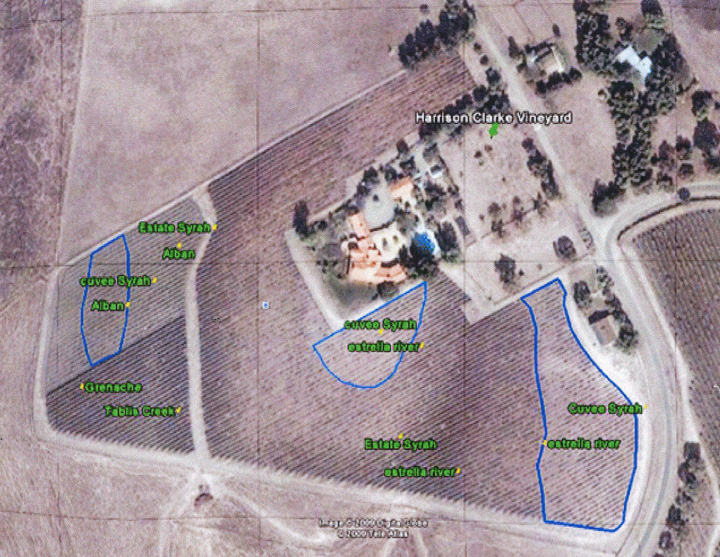 |
photo: courtesy of Harrison Clarke |
Beneath that sticky clay topsoil that was now caked on our shoes is the key to the Harrison Clarke Vineyard – chalky calcareous rock that in some places is only about a foot from the surface. The upper parts of the vineyard have the least topsoil, while farther down it extends a few feet below grade. We could see a few small limestoney rocks along the ground in the vine rows. The vineyard is planted to about ten acres of Syrah and 1½ acres of Grenache. There’s also a tiny new block of Viognier near Roger & Hilarie’s house across from the winery. This has exceedingly tight vine spacing – only 16” along the rows! Roger told us that he can always pull out some vines if it turns out the spacing is too tight. Most of the Syrah and Grenache vine spacing is 5’ x 8’, though the Alban clone Syrah block uses a tighter 30” x 8’ spacing. Harrison Clarke uses most of their vineyard’s fruit for their own wines, though they sell some to Jonata, Lillian, and Stolpman.
Walking into the winery building, Hilarie told us about the winemaking as she offered us tastes of the winery’s current releases plus a couple of barrel samples of their flagship “Cuvée Charlotte” Syrah. The grapes are all picked at night – Roger and Hilarie showed us photos from the night picks, with floodlights attached to the tractors in the vineyard. There are multiple picks from the vineyard, and Hilarie mentioned that they pick the south side of their Grenache vines first – that goes into the “Sorellina” bottling, while the north side fruit goes into their Harrison Clarke Estate Grenache.
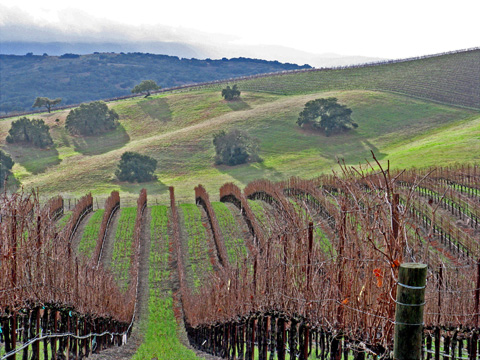 |
The initial fruit processing takes place in Lompoc, with the barrel aging at the small winery at their property. Sashi Moorman (of Stolpman, Evening Land, and Piedrasassi) is the winemaking consultant. Up to 2011, all of the grapes have been destemmed, using whole berries for the fermentations. In 2011, Harrison Clarke used 25% whole clusters in some of the lots, depending on the size and condition of the stems in various parts of the vineyard. This was an experiment for them, and they will have to see how the wine develops to decide whether they will continue to use some whole clusters. Fermentation proceeds with native yeasts, in two-ton open-top stainless steel fermenters. They do some pigeage during the fermentation, then use gentle basket pressing. Most wines are aged in 30-40% new oak. Various coopers are used, with mainly Hermitage for new barrels, and Taransaud and Sirugue for older barrels. Hilarie noted that they are using less new oak on the 2011 wines. After bottling, the Syrahs get around 13-14 months of bottle age prior to release, with a bit less for the Grenaches.
Harrison Clarke’s first release was from the 2003 vintage, and they have just released their first 2009 wine, the Grenache. Two of the wines are named for Roger & Hilarie’s daughters – “Cuvée Charlotte” Syrah, and “Sorellina” Grenache (“Sorellina” is Italian for “little sister”). The “Sorellina” was brighter with more upfront fruit than the Harrison Clarke Estate Grenache, and should be good for earlier drinking. The barrel samples and bottled “Cuvée Charlotte” Syrahs that we tasted were consistent in their floral character as well as in the chalky minerality that they displayed. Roger and Hilarie told us that the fruit that is selected for “Cuvée Charlotte” is farmed for lower yields and comes from parts of the vineyard where the limestone is closer to the surface. Total annual production of the Harrison Clarke wines is only about 1,000 cases, with most of that sold direct to consumers.
With such a small production level, it’s clear that Roger & Hilarie are in this for the love of it, and it shows in their vineyard and in their wines. The 2009 Estate Grenache and 2008 “Cuvée Charlotte” were my favorites, but all four were very good and quite distinct from one another. And the two “Cuvée Charlotte” barrel samples that we tasted were promising, though of course they still need time. The Harrison Clarke wines show off their terroir well, and do a good job of showcasing what can be done with Grenache and Syrah from Ballard Canyon. Roger & Hilarie were great hosts, and I’ve love to return sometime when the weather is more cooperative and I can take a walk through their vineyard (without picking up five pounds of clay on my shoes!).
Saying goodbye to Roger and Hilarie, we tried (not very successfully) to knock some of the vineyard mud from our shoes before climbing back into the car and returning to Solvang for a short break before dinner. Soon it was time for us to make the drive about 15 miles north to Los Alamos for dinner at Bell Street Farm. I had never eaten here before, and in fact had never heard of the place until Karen Steinwachs of Buttonwood suggested it as an alternative to Hitching Post for our large group. The café usually closes at 6pm, but Bell Street owner Jamie Gluck made an exception for us and took great care of our group.
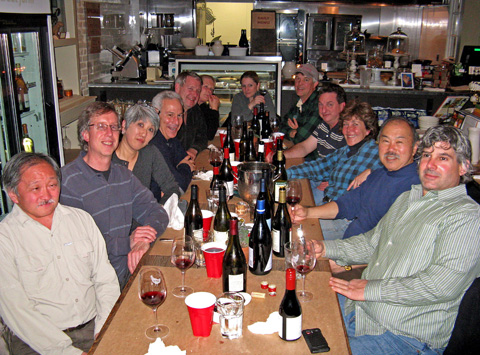 |
My traveling companions and I were joined for dinner by lots of Santa Barbara wine friends – Karen Steinwachs and husband Dave Robinson, Brian Loring, Peter Cargasacchi & Morgan Clendenen (of Cold Heaven), Peter & Rebecca Work (of Ampelos), and John Tomasso (he works in the restaurant supply business – a great person to ask about food recommendations!). Bell Street Farms was a perfect spot for an informal Monday night dinner – the food was terrific, and we were able to take advantage of a special menu for Santa Ynez Valley Restaurant Week. Most of us chose either the pork belly-wrapped rotisserie pork shoulder sandwich or the rotisserie half chicken, and both were extremely tasty.
And naturally, with so many winemakers at our dinner, there were plenty of their fine wines on the table. We enjoyed several Cargasacchi Pinots, Cold Heaven Syrah, Ampelos Pinot and Syrah, Loring Chardonnay, “Three” Pinot, and “Divergence” blend, and Buttonwood Grenache Blanc and Pinot Noir. We opened a few other wines too – a Dr. Loosen Riesling, Littorai Pinot, and Alban Syrah among others. It’s always great to see these friends when I’m in Santa Barbara County wine country – dedicated and hardworking for sure, but also just a hell of a fun group of people.
| Tuesday
- January 24, 2012 |
Kenneth Volk Vineyards
Tuesday morning, and time to pack up the car and start on our way home. Easier said than done, though…getting four people and their stuff (including several cases of wine by now) into one vehicle took a little work but we managed to do it. Getting an earlier start than the past couple of days, we made a quick stop to pick up some goodies at Mortensen's Danish Bakery in Solvang before getting back onto Highway 101 and starting on our way back north. The weather had cleared up again, and we had a smooth drive. We figured we had time for two or three winery stops in the Paso Robles area before driving the rest of the way home that afternoon, so we turned off the highway at Templeton and headed a few miles west until we arrived at the local tasting room of Kenneth Volk Vineyards.
Tasting Notes: Current Releases |
Kenneth Volk 2008 Viognier, Live Oak Vineyard, Paso Robles. Made in stainless steel. Light straw color, with aromas of ripe stone fruit along with notes of flowers and honey. Smooth mouthfeel and finish.
Kenneth Volk 2008 Roussanne, Paso Robles. Sourced from several vineyards, with most fruit coming from Pomar Junction Vineyard, and made in stainless steel. Light color, showing a minerally character along with pear and honey on the nose. Richer on the palate than the Viognier, but with enough acidity to keep it from being heavy.
Kenneth Volk 2007 Pinot Noir, “Santa Maria Cuvée,” Santa Maria Valley. The fruit comes from Bien Nacido, Garey, Nielson, Sierra Madre, and Solomon Hills vineyards. Medium ruby color, featuring earthy cherry, tea leaf, and spice, with a faint tomato note – very characteristic Santa Maria Valley Pinot. Medium-light bodied, with mild tannins.
Kenneth Volk 2007 Pinot Noir, Nielson Vineyard, Santa Maria Valley.Medium color, this displayed slightly riper strawberry and cherry fruit, with spice, a touch of sweet oak, and a savory component. Medium-bodied and more structured on the palate than the “Santa Maria Cuvée,” this had refined tannins on the finish, nice.
Kenneth Volk 2009 Blaufrankisch, Pomar Junction Vineyard, Paso Robles. Medium-dark purple, showing darker berry aromas along with clove and baking spices. Medium weight in the mouth but with a grippy finish.
Kenneth Volk 2009 Touriga, Pomar Junction Vineyard, Paso Robles. Made from Touriga Nacional. Medium-dark color, with a faint floral note plus ripe plum, earth, and dried herbs on the nose. Fairly full-bodied, with nice acidity and structure, and refined tannins on the lingering, tasty finish.
Kenneth Volk 2007 Syrah, Nielson Vineyard, Santa Maria Valley.Dark color, with bold aromas of spicy dark berry fruit, black pepper, and vanilla/oak, and a hint of smoky grilled meat. Medium-bodied with a big, chewy tannic finish.
|
|
Ken Volk is certainly a familiar name in Paso Robles wine country. He founded Templeton’s Wild Horse Winery in the early 1980s, releasing his first wine – a Pinot Noir from Santa Maria Valley – in 1983. Eventually the brand grew to an annual production of well over 100,000 cases, and Ken sold Wild Horse in 2003. It didn’t take him long to get back to the wine business, launching his own label in 2004. That year he purchased the old Byron Winery facility in Santa Maria Valley, and began making his own wine there. The first releases came in 2006. Ken had opened a tasting room at his winery (I visited there in 2007), but wanted a presence back in his old stomping ground, and he opened the second tasting room in spring of 2010.
The Kenneth Volk tasting room shares a building with the Lone Madrone tasting room at Fat Cat Farm. Formerly the old Sycamore Farm (where Bonny Doon once had a tasting room), there’s still an herb garden at Fat Cat, as well as goats, chickens…and, naturally, cats (though we didn’t spot them on our visit!). It’s a pleasant place to stop for those who might want a brief diversion from wine tasting. Of note is that Lone Madrone (and Tablas Creek) winemaker Neil Collins had worked with Ken Volk at Wild Horse Winery in the early 1990s.
Ryan at the tasting room told us a little about the vineyards and wines as he poured us a selection of the winery’s current releases. The Kenneth Volk wines are all made at the facility in Santa Maria Valley. Ken still produces Pinot Noir from that area – both single-vineyard designates and blends from multiple fruit sources. We tasted both a Pinot and a Syrah from Nielson Vineyard – as noted earlier, this was the first modern-day vineyard in Santa Barbara County, originally planted nearly 50 years ago. Both French and Hungarian oak barrels are used for the Pinots, with the Hungarian oak imparting some interesting spice aromas. The Viognier that we tasted was sourced from Live Oak Vineyard on the Westside of Paso, while the grapes for several other wines came from Pomar Junction Vineyard, located in the Eastside portion of the Templeton Gap.
Just as he did in years past at Wild Horse, Ken makes wines from a number of lesser-known grape varieties in California. He terms these his “Heirloom Wines” – made from grapes that are either not well-known or that don’t often get bottled on their own. Among the latter group is Mourvèdre, and although we didn’t taste it on this visit, the 2007 bottling that I tried at last year’s Rhone Rangers tasting in San Francisco was outstanding. We did taste two wines from the “Heirloom” group during our stop at the tasting room. One was the Blaufrankisch – a grape that originated in Central Europe, where it is known by a number of names, including Lemberger. The other was Touriga – from Portugal, this is widely used in making Port but has been increasingly used for making dry red wines. Other Kenneth Volk “Heirloom Wines” have included Verdehlo, Malvasia Bianca, Aglianico, Negrette, Cabernet Pfeffer, and Orange Muscat.
Favorites at Kenneth Volk included the Nielson Vineyard Pinot and the Touriga. Overall I felt the wines were good but not exceptional. Many of them tended to be on the softer side, though the Nielson Pinot and some of the bigger reds did feature more structure. They were all flavorful though, and the prospect of trying a Blaufrankisch or a Cabernet Pfeffer always makes visiting Ken Volk’s tasting room an interesting stop.
We decided to take advantage of the sunny day by having lunch on the patio of Farmstand 46, the fine café/deli that’s conveniently-located in the heart of Westside Paso Robles’ wine country. We enjoyed deli salads and hearty sandwiches and warmed up in the sun before heading on our way again. We turned off Highway 46 onto scenic Vineyard Drive, curving through the hills until we arrived at our next winery stop.
Tablas Creek Vineyard
We pulled into the parking area of Tablas Creek Vineyard. I’ve visited here a number of times but had not stopped by in several years, so now I got my first look at their new tasting room. Open for about a year, the new tasting room is considerably larger than the old one, which could often get quite crowded. A nice feature of the new, airy space is the wide expanse of glass that overlooks an array of large wood tanks and the 1,200-gallon oak foudres that Tablas Creek is noted for. Deanna Ryan welcomed us to the tasting room, where she was also serving two other small groups – among them a couple who mentioned that this was their first time ever tasting at any winery!
Tasting Notes: Current Releases |
Tablas Creek 2010 “Côtes de Tablas Blanc,” Paso Robles. 54% Viognier, 30% Grenache Blanc, 8% Marsanne, 8% Roussanne, fermented in stainless steel. Light straw color, with aromas of ripe stone fruit and tropical fruit, minerals, and a slight leesy note. Medium-bodied, with a dry, clean finish.
Tablas Creek 2010 “Esprit de Beaucastel Blanc,” Paso Robles.60% Roussanne, 35% Grenache Blanc, 5% Picpoul Blanc. Light yellow color, showing pear and stone fruits, plus spice, earth, honey, and vanilla/oak on the nose. Richer mouthfeel but with lively acidity on the long finish, nice.
Tablas Creek 2010 Rosé, Paso Robles.59% Mourvèdre, 30% Grenache, 11% Counoise. Light pink color, this displayed fresh ripe red berries, with hints of orangepeel, flowers, and spice. Medium-light weight on the palate, with a slight tannic bite on the finish.
Tablas Creek 2010 “Patelin de Tablas,” Paso Robles.39% Syrah, 36% Grenache, 22% Mourvèdre, 3% Counoise. Vibrant medium purple, featuring pretty floral aromas along with fresh red fruits, earth, iron, and spice. Medium-bodied and lively, with refined tannins and a long, flavorful finish. Very tasty value wine to drink now while you cellar the other Tablas Creek reds.
Tablas Creek 2010 “Côtes de Tablas,” Paso Robles. 46% Grenache, 39% Syrah, 10% Mourvèdre, 5% Counoise. Medium color, less fruit-forward than the “Patelin,” with earthy cherry and plum plus lots of spice. Nice acidity and more structure than the “Patelin.”
Tablas Creek 2009 “En Gobelet,” Paso Robles. 56% Mourvèdre, 23% Tannat, 21% Grenache. Medium purple color, aromas of earth, darker berry fruit, black pepper, and dried herbs. Medium-full bodied with a fairly smooth texture but finishing with big, chewy tannins. An intriguing wine that should improve with bottle age.
Tablas Creek 2009 “Esprit de Beaucastel,” Paso Robles.40% Mourvèdre, 28% Syrah, 27% Grenache, 5% Counoise. Medium-dark color, with slightly floral notes followed by earthy plum and darker fruit, earth, stony minerals, and herbs, with a faintly briny component. Big and structured on the palate but with more refined tannins than the “En Gobelet,” very nice.
|
|
Tablas Creek is co-owned by the Perrin family (of Château de Beaucastel fame) and Robert Haas (founder of Vineyard Brands importers). After buying a 120-acre property set deep in the hills west of Paso Robles, they began importing vine cuttings directly from Château de Beaucastel. Following the process of certifying the vines were virus-free (which takes three years), the vineyard was planted in the early 1990s. The vineyard is the heart of Tablas Creek’s operation – organically-farmed on hillsides of calcareous clay soil. In recent years, part of the vineyard has been farmed using biodynamic practices. The vines are planted more densely – from 1,600 to 1,800 vines per acre – than at most California vineyards, and many are head-trained in the style of Châteauneuf du Pape rather than on trellis systems. The preference is to dry-farm the vineyard, but in some years irrigation is necessary.
Tablas Creek currently grows nine Rhône grape varieties: Viognier, Marsanne, Roussanne, Grenache Blanc, Picpoul, Syrah, Grenache, Mourvèdre, Counoise, Roussanne, and Picpoul. They also grow small amounts of non-Rhône grapes, including Vermentino, Chardonnay, and Tannat. Many of the Rhône-variety vines planted throughout California came from cuttings brought to the US and propagated by Tablas Creek. In the winery, all the grapes are fermented using native yeasts. White grapes are whole-cluster pressed and are fermented in barriques, stainless steel, as well as in foudres (for Roussanne and Grenache Blanc). Reds are destemmed and, after blending, the wine is aged in the 1,200-gallon foudres. Recent total annual production has ranged from 12,000 to 19,000 cases, with the yield from the vines in different years creating the variance. The difficulties created by this natural vintage variation helped lead to a new set of Tablas Creek wines, “Patelin de Tablas.”
The winery launched the “Patelin de Tablas” wines – a white and a red – in 2011. Both blends, the white is based on Grenache Blanc while the red is based on Syrah. Unlike all of Tablas Creek’s other bottlings, which are sourced entirely from their estate vineyard, the fruit for these two comes partly from a number of neighboring vineyards as well as from their own. “Patelin de Tablas” can be translated as “neighborhood of Tablas,” and the grapes come from sustainable, organic, and biodynamic vineyards in the warmer Adelaida Hills and cooler Templeton Gap. Many of these growers have vines that originally came from Tablas Creek cuttings. Adding fruit from these neighboring growers to their line-up of wines allows Tablas Creek more flexibility to produce sufficient wine for their needs even in lower-yielding years. And adding the lower-priced and more fruit-forward “Patelin” blends (both at $20) also allows the winery to bump up the “Côtes de Tablas” bottlings from being their entry-level wines to more “serious” ones.
The two “Côtes de Tablas” wines are blends that are based on Viognier and on Grenache, respectively. Tablas Creek’s flagship wines are their Roussanne-based “Esprit de Beaucastel Blanc” and Mourvèdre-based “Esprit de Beaucastel” blends. The most complex and age-worthy of the winery’s regular releases, these are among the best in their style to be found in California. Though the winery’s emphasis is on blends, they also produce small quantities of varietal wines. Often available only through Tablas Creek’s wine club or at the tasting room, these include Roussanne, Marsanne, Grenache Blanc, Picpoul, Syrah, Grenache, and Mourvèdre, plus non-Rhônes Vermentino, Petit Manseng, and Tannat. In addition, there are occasional releases of special blends such as “En Gobelet” (which we were able to taste on this visit) and “Panoplie.” The “En Gobelet” is not made every year, and comes only from head-pruned, dry-farmed vines. The winery also makes a fine Mourvèdre-based dry Rosé and limited-production vin de paille-style dessert wines.
Deanna was a friendly and knowledgeable server (with a delightful English accent), and she poured us seven wines to taste. The 2010 “Côtes de Tablas” red blend that we tried was only recently bottled and had not been officially released at the time of our visit. The smaller yields in 2009 resulted in that vintage of the wine selling out earlier than normal – demonstrating the usefulness of introducing the “Patelin” blends into the Tablas Creek line-up. Deanna mentioned that they are planning to release a 100% Counoise – I’ll be looking forward to that, as the few examples of Counoise I’ve tasted from California have shown me that this variety is capable of making some exceptionally tasty wines.
I won’t deny that I’m drawn to the style of wine that Tablas Creek produces. Though they would seldom be mistaken for their Rhône cousins, these bottlings are more elegant and refined than most Rhône-style wines from California (and especially from Paso Robles). I enjoyed all of the wines we tasted, but my favorites were the “Patelin de Tablas,” the “En Gobelet,” and both of the “Esprit de Beaucastel” wines (white and red). It’s a pleasure to taste at the wines of Tablas Creek, and I think the new tasting room just adds to the experience.
Hug Cellars
When we had dinner with Raquel Hug and her nephew Jaime the preceding Friday evening, we promised her that we would stop by the winery on our way home, and we made it the final stop of our Central Coast trip. The winery is located in a small industrial park on the northeast edge of Paso Robles. Like a growing number of wineries these days, Hug Cellars does not own any vineyards, so they’re able to pick and choose the fruit that they want and bring it back to their facility to process.
Tasting Notes: Current Releases |
Hug 2010 “XOXO” Rosé, Central Coast. Made from Grenache, Mourvèdre, and Syrah. Light salmon-pink color, ripe strawberry, raspberry, and spice aromas, bright but smooth mouthfeel, with just a touch of tannin on the finish.
Hug 2010 “Vino del Cielo,” Cedar Lane Vineyard, Arroyo Seco.55% Chardonnay, 45% Viognier. Medium-light straw color, lightly floral aromas along with tropical fruit and a touch of spice. Medium-bodied, with a smooth but lively finish.
Hug 2007 Pinot Noir, Casa Torres Vineyard, Santa Maria Valley.Medium color, showing ripe red fruits along with lots of earth and dried herbs on the nose. Medium weight on the palate, with fairly mild tannins.
Hug 2010 Pinot Noir, Brosseau Vineyard, Chalone.Medium ruby color, more fruit-forward, with ripe raspberry and plum, cloves, baking spices, and vanilla/oak. Bigger mouthfeel and more structured than the Casa Torres bottling, with refined tannins on the finish.
Hug 2008 “el Papé,” Central Coast. 70% Grenache, 25% Mourvèdre, 5% Syrah, sourced from Cedar Lane and Santa Barbara Highlands vineyards. Medium-dark purple, featuring ripe strawberry, earth, mocha, and a chalky, mineral note. Medium-bodied, this had good acidity and finished with moderate tannins.
Hug 2008 “el Grandé,” Paso Robles.Syrah sourced from Terry Hoage Vineyard. Dark color, bold aromas of ripe blackberry, mocha, spice, and vanilla/oak. Big and mouthfilling texture, this finished with grippy tannins and lingering mocha flavors.
|
|
I first met Augie & Raquel Hug in the mid-1990s, when they ran a small wine shop and tasting room in the tiny village of Harmony, a few miles south of Cambria along Highway 1. They were among the friendliest people I’d met in the wine business (a business known for friendly people), and I returned to their shop every time I was in the area. Not long afterwards, I was intrigued by a bottle I spotted at the tasting bar of their shop – Hug Cellars Syrah. They’re making their own wine now? I had no idea. It turned out that was the very first Hug Cellars release, a 1994 Edna Valley Syrah that Augie produced at Alban Vineyards. Learning his winemaking from noted vintner John Alban and supplementing his knowledge with classes at UC Davis, Augie went on from there. Later on, he also worked on his wines for several years with Paul Wilkins – now of Alta Maria and Native9 – who had been the assistant winemaker at Alban Vineyards. Augie & Raquel left the wine shop business in 2000 to focus on their own winery.
Hug Cellars purchases grapes from as far north as Arroyo Seco in Monterey County, to Santa Maria Valley in the south, and out to Santa Barbara Highlands in far eastern Santa Barbara County. Augie has made a wide array of wines over the years, but has focused more on Pinot Noir, Rhône varieties, and more recently, Bordeaux varieties. A few years ago, he started shifting more of his production away from varietal and single vineyard wines and toward blends. Naturally, there are exceptions to this, and we tasted two single vineyard Pinot Noirs on our visit. Current blends include “el Pape” (a Châteauneuf-du-Pape style blend), “el Maestro” (mostly Grenache with some Syrah and Mourvèdre), “el Jefe” (another GSM blend), and “el Conquistador” (a red Bordeaux-style blend). The winery typically produces about 15 bottlings each year, with an average of around 1,500 total cases.
Raquel poured us six of Hug’s current releases. She told us about the contest the winery had for the bright red lip-print shown on the “XOXO” Rosé label (I can’t do justice to Raquel’s stories – each one seems to start out with “I kid you not!”). The new “Vino del Cielo” (Wine of Heaven) bottling is an interesting Chardonnay-Viognier blend that features a colorful label designed by friends Miguel & Linda Vazquez. The 2010 Brosseau Vineyard Pinot is the first release of this wine from Hug. Sourced from the well-regarded vineyard adjacent to the Chalone property in the Gabilan Mountains east of Salinas Valley, the area is noted for its chalky soil. We finished the tasting with the “el Grandé” Syrah. The fruit for this came from Terry Hoage’s vineyard on the Westside of Paso Robles, and the wine’s name is a excellent description of it – if you like big Paso Syrahs, this is one fits the bill.
A visit to Hug Cellars is an enjoyable stop, especially when Raquel is behind the tasting bar. My favorites on this visit were the Casa Torres Vineyard Pinot and the “el Pape” Rhône-style blend. The Hug wines have been consistent in their overall style, even as they have moved toward featuring more blends than varietal wines. They tend to be big and flavorful but not over-ripe, with good balance and the structure for aging. And how can you go wrong with a winery whose motto is “give your tongue a Hug”!
This was another enjoyable trip to the Central Coast for me. Despite trying to squeeze a lot of wineries into a short timeframe, it was fun to introduce a couple more of my friends to the wines of the region. We visited three wineries with surprising roots in the Louisiana/Gulf Coast area. And we learned about so many Central Coast vintners whose paths have crossed time and again over the years, and continue to do so today. Our schedule didn’t allow us to get to every place we would have liked – for example we missed out on the Lompoc-area wineries entirely on this trip – but that just creates another good reason to return soon.
The overall quality of the wines we tasted along the way was high, and it’s good to see some of the newer wineries in the area seeking to set the bar even higher. The landscape, people, and wine of the Central Coast remain special to me, and I’ll be back there again before long. As always, thanks to everyone that we visited for being so generous with their time and their wine!
[Additional Reviews & Journals from Ken Zinns]
|


